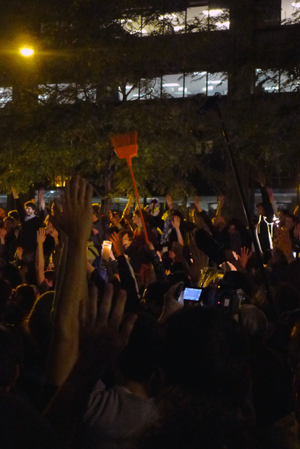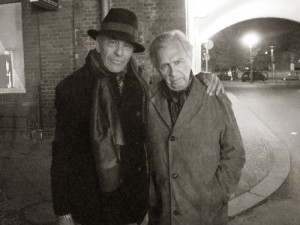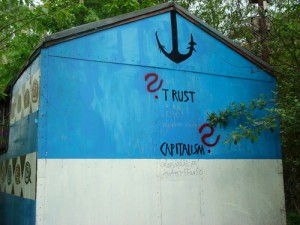Author Archive
 This Is What 2012 Looks Like
This Is What 2012 Looks Like
by Ayesha Adamo
 This is what 2012 looks like, in case you were wondering. I spent my New Year's Eve in Liberty Square here in New York, ready to occupy the New Year. If you were there, then you know. If you weren't, then let me tell you that as I watched the team from Direct Action swoop in and pull barricades down, winning a tug-of-war against the cops who were outnumbered for once, thanks to the festivities in Times Square, I knew that this was the best New Year's Eve of my life.
I knew it even more so as I, with my fellow occupiers, climbed the great pile of barricades that the people had tossed into the middle of the park. We stood on top, looked out over the sea of faces that had gathered, and shook the ground. And you could just tell—the myths are finally here: this is what 2012 was always meant to be. This is what I've been waiting for all my life.
Later the NYPD battalions in riot gear would descend upon the park, kicking out the few of us who decided not to go on the march to the East Village, but it was already too late: the ground had already been shaken and the barricades had already toppled. The symbol, the ritual, had already been completed, set into motion...the magick button had been pressed and no matter how many arrests were made that night, nothing could change it. Standing outside the 9th Precinct at 4 in the morning to cheer our warriors as they exited the paddy wagon, and get an idea of names to pass on to the National Lawyers Guild, the night was winding down, but with the knowledge that nothing was over. Far far from it. Viva la revolución! Viva 2012!
This is what 2012 looks like, in case you were wondering. I spent my New Year's Eve in Liberty Square here in New York, ready to occupy the New Year. If you were there, then you know. If you weren't, then let me tell you that as I watched the team from Direct Action swoop in and pull barricades down, winning a tug-of-war against the cops who were outnumbered for once, thanks to the festivities in Times Square, I knew that this was the best New Year's Eve of my life.
I knew it even more so as I, with my fellow occupiers, climbed the great pile of barricades that the people had tossed into the middle of the park. We stood on top, looked out over the sea of faces that had gathered, and shook the ground. And you could just tell—the myths are finally here: this is what 2012 was always meant to be. This is what I've been waiting for all my life.
Later the NYPD battalions in riot gear would descend upon the park, kicking out the few of us who decided not to go on the march to the East Village, but it was already too late: the ground had already been shaken and the barricades had already toppled. The symbol, the ritual, had already been completed, set into motion...the magick button had been pressed and no matter how many arrests were made that night, nothing could change it. Standing outside the 9th Precinct at 4 in the morning to cheer our warriors as they exited the paddy wagon, and get an idea of names to pass on to the National Lawyers Guild, the night was winding down, but with the knowledge that nothing was over. Far far from it. Viva la revolución! Viva 2012!
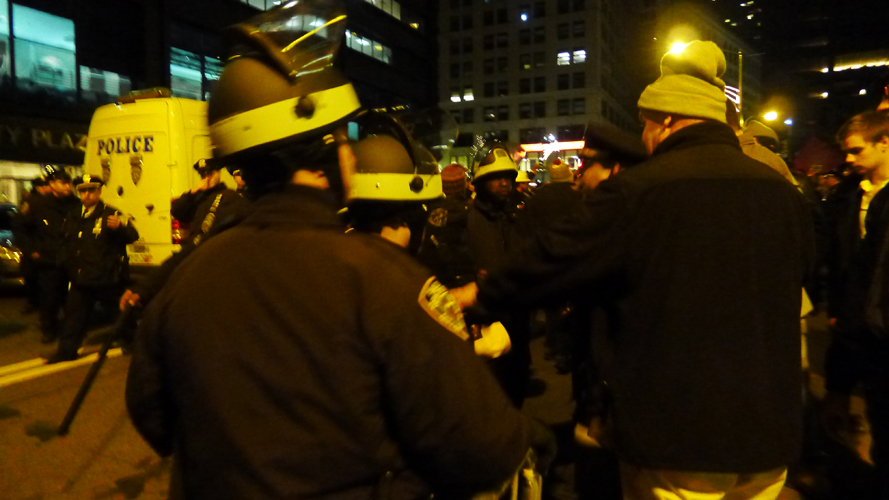
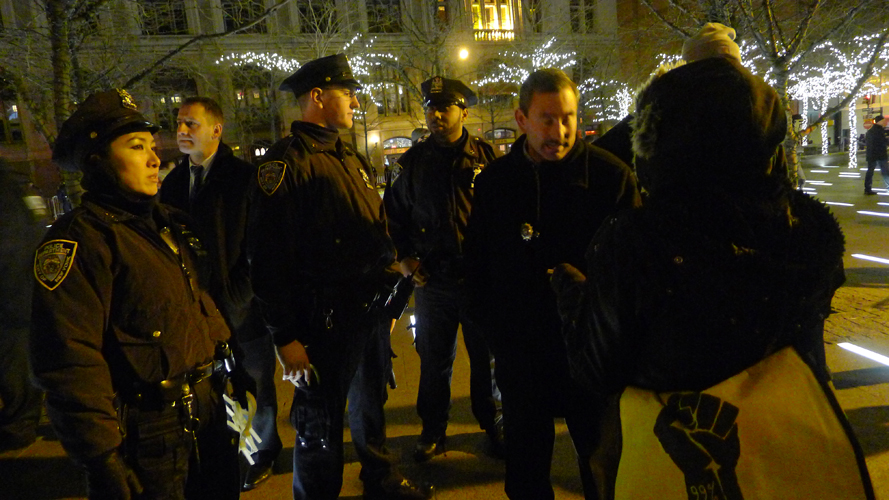
 This is what 2012 looks like, in case you were wondering. I spent my New Year's Eve in Liberty Square here in New York, ready to occupy the New Year. If you were there, then you know. If you weren't, then let me tell you that as I watched the team from Direct Action swoop in and pull barricades down, winning a tug-of-war against the cops who were outnumbered for once, thanks to the festivities in Times Square, I knew that this was the best New Year's Eve of my life.
I knew it even more so as I, with my fellow occupiers, climbed the great pile of barricades that the people had tossed into the middle of the park. We stood on top, looked out over the sea of faces that had gathered, and shook the ground. And you could just tell—the myths are finally here: this is what 2012 was always meant to be. This is what I've been waiting for all my life.
Later the NYPD battalions in riot gear would descend upon the park, kicking out the few of us who decided not to go on the march to the East Village, but it was already too late: the ground had already been shaken and the barricades had already toppled. The symbol, the ritual, had already been completed, set into motion...the magick button had been pressed and no matter how many arrests were made that night, nothing could change it. Standing outside the 9th Precinct at 4 in the morning to cheer our warriors as they exited the paddy wagon, and get an idea of names to pass on to the National Lawyers Guild, the night was winding down, but with the knowledge that nothing was over. Far far from it. Viva la revolución! Viva 2012!
This is what 2012 looks like, in case you were wondering. I spent my New Year's Eve in Liberty Square here in New York, ready to occupy the New Year. If you were there, then you know. If you weren't, then let me tell you that as I watched the team from Direct Action swoop in and pull barricades down, winning a tug-of-war against the cops who were outnumbered for once, thanks to the festivities in Times Square, I knew that this was the best New Year's Eve of my life.
I knew it even more so as I, with my fellow occupiers, climbed the great pile of barricades that the people had tossed into the middle of the park. We stood on top, looked out over the sea of faces that had gathered, and shook the ground. And you could just tell—the myths are finally here: this is what 2012 was always meant to be. This is what I've been waiting for all my life.
Later the NYPD battalions in riot gear would descend upon the park, kicking out the few of us who decided not to go on the march to the East Village, but it was already too late: the ground had already been shaken and the barricades had already toppled. The symbol, the ritual, had already been completed, set into motion...the magick button had been pressed and no matter how many arrests were made that night, nothing could change it. Standing outside the 9th Precinct at 4 in the morning to cheer our warriors as they exited the paddy wagon, and get an idea of names to pass on to the National Lawyers Guild, the night was winding down, but with the knowledge that nothing was over. Far far from it. Viva la revolución! Viva 2012!


 Last Night at Liberty…
Last Night at Liberty…
I wasn't there, but my good friend Stephen Boyer was. Acts of brutality from the Mayor and the police such as this only clean the stage for great stories of heroism. This is one of them:
http://minorprogression.com/2011/11/15/emotional-night-in-liberty-square/
 Four-letter words like Love and Hope
Four-letter words like Love and Hope
 Sometimes a song comes along with a shitty, repetitive chorus, and it all goes down like melba toast…like when John Mayer once encouraged us to “Say what (we) mean to say” in eight not-so-different ways. Other times, there’s the repetitive chorus that we’re meant to be able to remember—even while shit-faced on Patron…like when Taio Cruz tells that “Little Bad Girl” to just “Go” already, stamping along in time to some David Guetta beats.
But once in a while the simplest, most repetitive phrase in a song can mean everything. This is when you’re breathing that rare air of The Doors’ “Indian Summer.” Jim Morrison and Robby Krieger work their magic(k), and suddenly, “I love you the best. Better than all the rest” is like the most profound lyric you’ve ever heard. Sometimes a pop song comes along and hits in just the right way, at just the right time. Such is the case with Rihanna’s new song, “We Found Love.”
“We found love in a hopeless place.” There it is: the moment. You don’t need to say anything else. There’s no need to riff on an explanation of that; you’ve probably known what it means since the beginning of time. “We found love in a hopeless place.” That’s everything. You know exactly what it is.
Hearing this song while thrift store shopping for used clothes that the character in my new play might wear does things to me. Powerful things. It’s like a huge homage to a time in my life when I did have hope, and I don’t just mean a general kind of universal hope for the future, the suspension of doom that was the 1990’s, I mean on a personal level. It’s those opening synth sounds that remind you of Crystal Waters’ “Gypsy Woman”…it’s like you already know this song, could recognize it anywhere, always knew it. When you listen to what Calvin Harris did, the reference to 90’s house music right from the very first moments of the track, already you’re transported to a time when people weren’t glued to their cell phones or email, when there was this new kind of strangely innocent thing, this dance music, this acid house, this scene that had its grisly dark side of OD’s on the dancefloor, but more than that just had a lot of love. This is the synthesized voice of love in analog.
And then there’s the video. This is no Lady Gaga over-priced hack-job imitation of the material girl’s ambitiously blond anthology, in which Gaga, the born-rich “artiste,” stares gauntly into the camera in an attempt to convince you that there’s something big and emotional and powerful in her when in fact it’s just another shade of neon in her vacancy sign.
No!
The beauty from Barbados actually feels things in this video and we feel them too. The people who put this video together knew what the hell they were doing. They stole all the right stuff: the dilating pupils and bathtub moments from Requiem for a Dream, the grey-skied open fields and flop houses from Trainspotting…this is divine 90’s montage: this video is perfect. It’s perfect because it’s actually presenting images from an era that was hopeful, in the same way that Harris’ musical track calls on the sounds of some seemingly-ancient rave time, so you feel the hopelessness of now even more. Sure, they could have shown images of children playing joyfully by fracking wells, or couples embracing while on the unemployment line in, like, Gary, Indiana or something. That would have been love in a hopeless place too, but that would have been too explicit. All that is already implied. And it doesn’t matter that there are shades of Rihanna and Chris Brown’s relationship in the video. Nobody cares. Chris Brown is just fuel for the story. And the story is beautiful. This past weekend, a poet friend of mine asked me if I've ever really been in love. I think you know love when you see it and the real thing looks just like this music video and sounds just like this song. I might as well just say it: I wish I could afford to do something this good…and I can’t.
Instead, I spend time at Zuccotti Park and sometimes I sing down there with just the voice that I have, a voice that can almost sort of compete with the sound of jack-hammers and the general assembly. And it is beautiful. It is one of the only beautiful things I’ve experienced for myself as a performer in a long time. It is beautiful, but it is small. Too small for me. I always long to do something meaningful. I’m not always that hopeful about it. For now, I’m just one RSS feed in a giant trough of RSS feed. So I become a part of something, something that I’m already a part of: the 99 percent. I’m no Rihanna. I wish I could be Rihanna. I wish this were my song, but I’m faceless and nameless and the best my voice can hope for is to be a part of the roar of the great din, the crashing on the shore, which has its own cacophonous majesty. In a sea of stars, there’s no shine in particular, just sameness. But it’s an amazing kind of sameness. Invisibility is a kind of superhero power too. This coming moment might be the end of the era of having a name. In so many Guy Fawkes masks, we’re all Anonymous and who knows what kind of songs will come from the nameless, but maybe we will find a more hopeful place.
Thanks to Michael Geffner for the photo at OWS Poetry Assembly, above.
Sometimes a song comes along with a shitty, repetitive chorus, and it all goes down like melba toast…like when John Mayer once encouraged us to “Say what (we) mean to say” in eight not-so-different ways. Other times, there’s the repetitive chorus that we’re meant to be able to remember—even while shit-faced on Patron…like when Taio Cruz tells that “Little Bad Girl” to just “Go” already, stamping along in time to some David Guetta beats.
But once in a while the simplest, most repetitive phrase in a song can mean everything. This is when you’re breathing that rare air of The Doors’ “Indian Summer.” Jim Morrison and Robby Krieger work their magic(k), and suddenly, “I love you the best. Better than all the rest” is like the most profound lyric you’ve ever heard. Sometimes a pop song comes along and hits in just the right way, at just the right time. Such is the case with Rihanna’s new song, “We Found Love.”
“We found love in a hopeless place.” There it is: the moment. You don’t need to say anything else. There’s no need to riff on an explanation of that; you’ve probably known what it means since the beginning of time. “We found love in a hopeless place.” That’s everything. You know exactly what it is.
Hearing this song while thrift store shopping for used clothes that the character in my new play might wear does things to me. Powerful things. It’s like a huge homage to a time in my life when I did have hope, and I don’t just mean a general kind of universal hope for the future, the suspension of doom that was the 1990’s, I mean on a personal level. It’s those opening synth sounds that remind you of Crystal Waters’ “Gypsy Woman”…it’s like you already know this song, could recognize it anywhere, always knew it. When you listen to what Calvin Harris did, the reference to 90’s house music right from the very first moments of the track, already you’re transported to a time when people weren’t glued to their cell phones or email, when there was this new kind of strangely innocent thing, this dance music, this acid house, this scene that had its grisly dark side of OD’s on the dancefloor, but more than that just had a lot of love. This is the synthesized voice of love in analog.
And then there’s the video. This is no Lady Gaga over-priced hack-job imitation of the material girl’s ambitiously blond anthology, in which Gaga, the born-rich “artiste,” stares gauntly into the camera in an attempt to convince you that there’s something big and emotional and powerful in her when in fact it’s just another shade of neon in her vacancy sign.
No!
The beauty from Barbados actually feels things in this video and we feel them too. The people who put this video together knew what the hell they were doing. They stole all the right stuff: the dilating pupils and bathtub moments from Requiem for a Dream, the grey-skied open fields and flop houses from Trainspotting…this is divine 90’s montage: this video is perfect. It’s perfect because it’s actually presenting images from an era that was hopeful, in the same way that Harris’ musical track calls on the sounds of some seemingly-ancient rave time, so you feel the hopelessness of now even more. Sure, they could have shown images of children playing joyfully by fracking wells, or couples embracing while on the unemployment line in, like, Gary, Indiana or something. That would have been love in a hopeless place too, but that would have been too explicit. All that is already implied. And it doesn’t matter that there are shades of Rihanna and Chris Brown’s relationship in the video. Nobody cares. Chris Brown is just fuel for the story. And the story is beautiful. This past weekend, a poet friend of mine asked me if I've ever really been in love. I think you know love when you see it and the real thing looks just like this music video and sounds just like this song. I might as well just say it: I wish I could afford to do something this good…and I can’t.
Instead, I spend time at Zuccotti Park and sometimes I sing down there with just the voice that I have, a voice that can almost sort of compete with the sound of jack-hammers and the general assembly. And it is beautiful. It is one of the only beautiful things I’ve experienced for myself as a performer in a long time. It is beautiful, but it is small. Too small for me. I always long to do something meaningful. I’m not always that hopeful about it. For now, I’m just one RSS feed in a giant trough of RSS feed. So I become a part of something, something that I’m already a part of: the 99 percent. I’m no Rihanna. I wish I could be Rihanna. I wish this were my song, but I’m faceless and nameless and the best my voice can hope for is to be a part of the roar of the great din, the crashing on the shore, which has its own cacophonous majesty. In a sea of stars, there’s no shine in particular, just sameness. But it’s an amazing kind of sameness. Invisibility is a kind of superhero power too. This coming moment might be the end of the era of having a name. In so many Guy Fawkes masks, we’re all Anonymous and who knows what kind of songs will come from the nameless, but maybe we will find a more hopeful place.
Thanks to Michael Geffner for the photo at OWS Poetry Assembly, above.
 Trigger93: FLESH! out now!
Trigger93: FLESH! out now!
 Remember remember the fifth of November...
The all new issue of Trigger93 is out now!
Check it out here:
www.trigger93.com
Remember remember the fifth of November...
The all new issue of Trigger93 is out now!
Check it out here:
www.trigger93.com
 Sweeping the Park, Sweeping the Nation
Sweeping the Park, Sweeping the Nation
By Ayesha Adamo
Everyone has heard about the occupation. Everyone has seen the Youtube videos of police arrests and celebrity interviews. But on the eve of eviction, in the sometimes-pouring rain and thunder, in the middle of the night…there is another story to be told.
This is what you don’t get to see or hear as much about: the simple beauty of the exhausted, damp and nameless pushing brooms in a slow moving swarm from one end of the park to the other, here in the evening’s damp haze made shimmering by the remaining lights from the buildings above. This is when the celebrities and their spotlights and agendas are nowhere to be found (except that we were sweeping with none other than Santa Claus himself, all dressed in red). During the quiet moments, everyone’s a leader and no one’s a leader.
Part of me was thinking with concern about the runoff contamination from the cleaning agents in these suds, as we were mopping along a stream of soap bubbles, leaves, bits of salami and abandoned hair elastics, but it also seemed to be a necessary evil. It’s likely that the cleaning effort had a big impact on the city’s decision not to evict the protesters.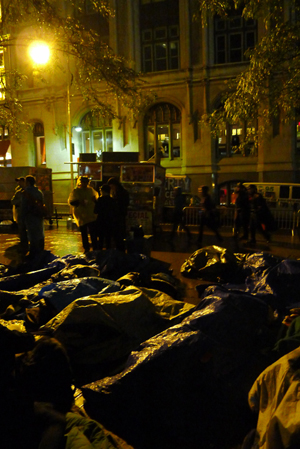 Throughout the night and into the morning, truckers would drive past and honk their horns loudly in solidarity, which was always met with cheers, no matter the hour. We slept on the plain ground covered with only a plastic bag to keep dry because the plan that night was to minimize the amount of sleeping bags and bedding in the park. As 5am approached, a girl came by giving out dry socks to people. Others passed around Sharpies to write the phone number of the lawyers on their body in case of arrest.
More and more people were showing up at the park, and by 6am, it was a sea of bodies as far as you could see in any direction—so far out that any statement over the people’s mic needed to be repeated in three or four ripples. So many faces, so many lights!—from cell phones, candles, video cameras…But when the breaking news came over the crowd—the news that the cleaning/eviction had been canceled—this enormous group was so unified that the words needed no repetition. From the cheers of joy alone, everybody knew. And everybody knew that they had just experienced something absolutely historic, I dare say absolutely spiritual.
Throughout the night and into the morning, truckers would drive past and honk their horns loudly in solidarity, which was always met with cheers, no matter the hour. We slept on the plain ground covered with only a plastic bag to keep dry because the plan that night was to minimize the amount of sleeping bags and bedding in the park. As 5am approached, a girl came by giving out dry socks to people. Others passed around Sharpies to write the phone number of the lawyers on their body in case of arrest.
More and more people were showing up at the park, and by 6am, it was a sea of bodies as far as you could see in any direction—so far out that any statement over the people’s mic needed to be repeated in three or four ripples. So many faces, so many lights!—from cell phones, candles, video cameras…But when the breaking news came over the crowd—the news that the cleaning/eviction had been canceled—this enormous group was so unified that the words needed no repetition. From the cheers of joy alone, everybody knew. And everybody knew that they had just experienced something absolutely historic, I dare say absolutely spiritual.
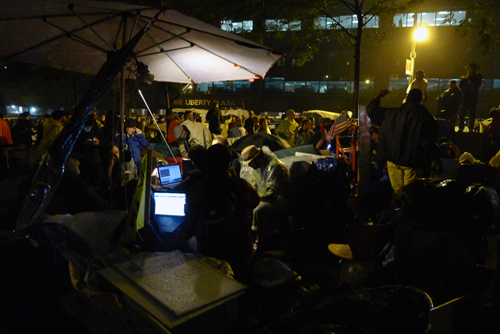
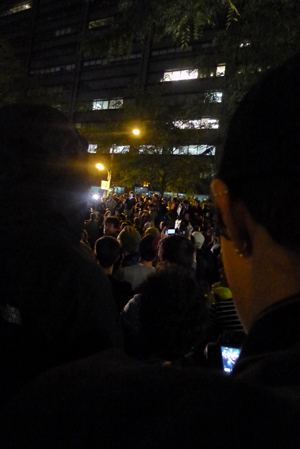
 Throughout the night and into the morning, truckers would drive past and honk their horns loudly in solidarity, which was always met with cheers, no matter the hour. We slept on the plain ground covered with only a plastic bag to keep dry because the plan that night was to minimize the amount of sleeping bags and bedding in the park. As 5am approached, a girl came by giving out dry socks to people. Others passed around Sharpies to write the phone number of the lawyers on their body in case of arrest.
More and more people were showing up at the park, and by 6am, it was a sea of bodies as far as you could see in any direction—so far out that any statement over the people’s mic needed to be repeated in three or four ripples. So many faces, so many lights!—from cell phones, candles, video cameras…But when the breaking news came over the crowd—the news that the cleaning/eviction had been canceled—this enormous group was so unified that the words needed no repetition. From the cheers of joy alone, everybody knew. And everybody knew that they had just experienced something absolutely historic, I dare say absolutely spiritual.
Throughout the night and into the morning, truckers would drive past and honk their horns loudly in solidarity, which was always met with cheers, no matter the hour. We slept on the plain ground covered with only a plastic bag to keep dry because the plan that night was to minimize the amount of sleeping bags and bedding in the park. As 5am approached, a girl came by giving out dry socks to people. Others passed around Sharpies to write the phone number of the lawyers on their body in case of arrest.
More and more people were showing up at the park, and by 6am, it was a sea of bodies as far as you could see in any direction—so far out that any statement over the people’s mic needed to be repeated in three or four ripples. So many faces, so many lights!—from cell phones, candles, video cameras…But when the breaking news came over the crowd—the news that the cleaning/eviction had been canceled—this enormous group was so unified that the words needed no repetition. From the cheers of joy alone, everybody knew. And everybody knew that they had just experienced something absolutely historic, I dare say absolutely spiritual.


 The Beginning is Here
The Beginning is Here
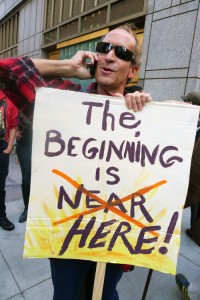 by Ayesha Adamo
With a clear blue sky and weather almost warm enough to go topless (and there were some who did), they couldn't have picked a better day for a protest. On Wednesday 10/5/11, I came down to Occupy with the Columbia University contingent, a truly boisterous group that kept the chanting going non-stop using "the people's mic" technique, which has proved so helpful in an action where no amplification is allowed (everyone repeats after the central speaker so that the message travels out to rings of people further and further away).
Down at Wall Street, all the groups seemed to melt into one another. There were union groups, student groups, a marching band with four tubas, a kindergarten class holding a banner together and chanting in tiny voices to share and not be greedy...just people of every sort imaginable coming together to express the need for a real change in the way things are now. And there didn't need to be just one reason to be there because this is the new way of protesting, of understanding. This is the rhizome, like the world wide web, and the links and connections between one thing and another don't need to make sense in a linear format. They only need to be. Just to be seen by the people in those tall buildings who don't touch public pavement is a win, and a person would have to be cold-as-dead to look out on a crowd like this and not be moved. When I look around at all these faces—their eyes, hearts, the blood in their veins—I feel like I've been waiting for this all my life, and finally...The Beginning is Here.
by Ayesha Adamo
With a clear blue sky and weather almost warm enough to go topless (and there were some who did), they couldn't have picked a better day for a protest. On Wednesday 10/5/11, I came down to Occupy with the Columbia University contingent, a truly boisterous group that kept the chanting going non-stop using "the people's mic" technique, which has proved so helpful in an action where no amplification is allowed (everyone repeats after the central speaker so that the message travels out to rings of people further and further away).
Down at Wall Street, all the groups seemed to melt into one another. There were union groups, student groups, a marching band with four tubas, a kindergarten class holding a banner together and chanting in tiny voices to share and not be greedy...just people of every sort imaginable coming together to express the need for a real change in the way things are now. And there didn't need to be just one reason to be there because this is the new way of protesting, of understanding. This is the rhizome, like the world wide web, and the links and connections between one thing and another don't need to make sense in a linear format. They only need to be. Just to be seen by the people in those tall buildings who don't touch public pavement is a win, and a person would have to be cold-as-dead to look out on a crowd like this and not be moved. When I look around at all these faces—their eyes, hearts, the blood in their veins—I feel like I've been waiting for this all my life, and finally...The Beginning is Here.
 Trigger93
Trigger93
 I know it's been ages since I've posted here, but it's only because I've been putting my writing and editing energies to good use by starting an edgy, magickal, artistic, and somewhat-academic zine called Trigger93.
I know it's been ages since I've posted here, but it's only because I've been putting my writing and editing energies to good use by starting an edgy, magickal, artistic, and somewhat-academic zine called Trigger93.  Our first print issue came out in late December of 2010 and is available for purchase at www.trigger93.com. The Trigger team has also put together the first of many mini issues called Trigger93 Interludes, and Interludes 1 is available for free download on the website as well (donations appreciated!). Our articles touch on a variety of topics, from activism to art and beyond, generally with a nod to all things spiritual, alchemical or uncanny. Hope you'll check it out and spread the word!
xoxo,
Ayesha
Our first print issue came out in late December of 2010 and is available for purchase at www.trigger93.com. The Trigger team has also put together the first of many mini issues called Trigger93 Interludes, and Interludes 1 is available for free download on the website as well (donations appreciated!). Our articles touch on a variety of topics, from activism to art and beyond, generally with a nod to all things spiritual, alchemical or uncanny. Hope you'll check it out and spread the word!
xoxo,
Ayesha
 The Tax Cut Endgame
The Tax Cut Endgame
by David Deau
 President Obama's recent deal with the Republicans to extend the Bush-era tax cuts is a win for the Republicans and another push for the decline of Western civilization. This deal includes estate tax cuts for multimillionaires and billionaires…after the Republicans threatened not to extend unemployment benefits for the estimated 2 million unemployed (a number believed to quadruple within a year).
Apparently, the politicians that the hardworking middle and lower class Americans elected into office are going to make them suffer unless the rich can get richer. The Bush tax cuts do little to help the middle or lower classes, but do continue to help the rich get richer. The tax cuts will only amount to a few hundred dollars for middle class families, but luckily, both lower and middle class families will be able to compound their benefits by the addition of the estate tax cuts—just like the wealthy folks do, right? And we all know that hardworking middle and lower class Americans tend to have large estates.
President Obama seems to have run out of steam, and the hope of re-establishing the foundation that this country was built on is fleeting fast—or should I say gone. Does anyone remember, “Life, Liberty, and Pursuit of Happiness?” It seems as though the President was set-up once again, if we consider the following quote from Bush's communications director on the Bush tax cuts:
“We knew that, politically, once you get it into law, it becomes almost impossible to remove it,” says Dan Bartlett, Bush’s former communications director. “That’s not a bad legacy. The fact that we were able to lay the trap does feel pretty good, to tell you the truth.”
•••
We have gone from our GDP (production) growing more than twice as fast as our debt, to our debt growing at nearly four times the speed of our GDP. A train wreck is getting ready to happen and this train wreck is literally unstoppable.
—National Inflation Association
The world knows what is happening in the US and they have begun to position themselves for the imminent collapse. China and Russia have decided to renounce the US dollar and resort to using their own currencies for bilateral trade, Premier Wen Jiabao and his Russian counterpart Vladimir Putin announced late on Tuesday, November 23 in St. Petersburg. (View Article)
The wealthy are doing everything they can to hold onto what they have because they know the next step is to begin austerity measures on US citizens. This is happening all over the world as a domino effect. In fact, a presidential commission studying the deficit identified austere measures last week to cut $4 trillion from the federal budget over the next decade. HOLD ON ITS COMING.
Let’s look at what is happening around the world:
Ireland: Ireland is spending more than 50 billion euros on regular government activities this year, and collecting just 31 billion euros in taxes, for an underlying deficit of 12%—four times the limit for members of the European currency union. Exceptional bank-bailout costs on top of that have driven this year's deficit to 32% of gross domestic product, a postwar European record. Ireland was forced to admit defeat in its two-year effort to fight its runaway deficit while plowing at least 45 billion euros into a bank bailout. The escalating bank bill put the nation on course for bankruptcy next year, as its borrowing costs surged to unsustainable highs on bond markets. "The banks have brought this country to its knees. We'll be paying for their mistakes for the rest of our lives," said Alice Dunleavy, 30, a civil servant.
Spain: The Spanish government approved new austerity measures and a limited economic stimulus package to ease investor fears about its debt and insisted again that the country is taking strong steps to right its ailing economy.
On Tuesday, European finance ministers pressured the Eurozone's weaker members to get a grip on their finances, one day after they refused to increase the 750 billion euro ($1 trillion) bailout fund. With Ireland joining Greece in getting bailed out, the markets have fretted about which country will be next — Portugal and Spain are viewed by many as the weakest links in the 16-country currency union and the EU's finance ministers are continuing to press them to get their financial houses in order.
On December 5, 2010, the Guardian reported that the British Chambers of Commerce will cut their short-term forecast for growth in Britain's faltering economy, warning of fragility in household finances and tepid consumer spending as the coalition's austerity measures begin to bite. (Guardian Article)
To sum all this up: it’s “Take from the poor and give to the rich,” a divided world in the name of the greed of the few! How long are Americans going to put up with it? You can search the Internet and see the protests going on around the world. The protests over austerity measures have been taking place in the following regions: Belgium, Czech Republic, France, Germany, Greece, Poland, Portugal, Romania, Spain, and the UK. Yet the American people are too busy watching sports or celebrities on television to join the fight for their own freedom.
Where are the Americans that really remember the words in the Preamble to the Constitution: “promote the general Welfare, and secure the Blessings of Liberty to ourselves and our Posterity.”
Have our last symbols of the fight for freedom passed with the assassination of John F. Kennedy and Martin Luther King Jr., with the dissolution of the Weathermen? This country was built on Revolution!
President Obama's recent deal with the Republicans to extend the Bush-era tax cuts is a win for the Republicans and another push for the decline of Western civilization. This deal includes estate tax cuts for multimillionaires and billionaires…after the Republicans threatened not to extend unemployment benefits for the estimated 2 million unemployed (a number believed to quadruple within a year).
Apparently, the politicians that the hardworking middle and lower class Americans elected into office are going to make them suffer unless the rich can get richer. The Bush tax cuts do little to help the middle or lower classes, but do continue to help the rich get richer. The tax cuts will only amount to a few hundred dollars for middle class families, but luckily, both lower and middle class families will be able to compound their benefits by the addition of the estate tax cuts—just like the wealthy folks do, right? And we all know that hardworking middle and lower class Americans tend to have large estates.
President Obama seems to have run out of steam, and the hope of re-establishing the foundation that this country was built on is fleeting fast—or should I say gone. Does anyone remember, “Life, Liberty, and Pursuit of Happiness?” It seems as though the President was set-up once again, if we consider the following quote from Bush's communications director on the Bush tax cuts:
“We knew that, politically, once you get it into law, it becomes almost impossible to remove it,” says Dan Bartlett, Bush’s former communications director. “That’s not a bad legacy. The fact that we were able to lay the trap does feel pretty good, to tell you the truth.”
•••
We have gone from our GDP (production) growing more than twice as fast as our debt, to our debt growing at nearly four times the speed of our GDP. A train wreck is getting ready to happen and this train wreck is literally unstoppable.
—National Inflation Association
The world knows what is happening in the US and they have begun to position themselves for the imminent collapse. China and Russia have decided to renounce the US dollar and resort to using their own currencies for bilateral trade, Premier Wen Jiabao and his Russian counterpart Vladimir Putin announced late on Tuesday, November 23 in St. Petersburg. (View Article)
The wealthy are doing everything they can to hold onto what they have because they know the next step is to begin austerity measures on US citizens. This is happening all over the world as a domino effect. In fact, a presidential commission studying the deficit identified austere measures last week to cut $4 trillion from the federal budget over the next decade. HOLD ON ITS COMING.
Let’s look at what is happening around the world:
Ireland: Ireland is spending more than 50 billion euros on regular government activities this year, and collecting just 31 billion euros in taxes, for an underlying deficit of 12%—four times the limit for members of the European currency union. Exceptional bank-bailout costs on top of that have driven this year's deficit to 32% of gross domestic product, a postwar European record. Ireland was forced to admit defeat in its two-year effort to fight its runaway deficit while plowing at least 45 billion euros into a bank bailout. The escalating bank bill put the nation on course for bankruptcy next year, as its borrowing costs surged to unsustainable highs on bond markets. "The banks have brought this country to its knees. We'll be paying for their mistakes for the rest of our lives," said Alice Dunleavy, 30, a civil servant.
Spain: The Spanish government approved new austerity measures and a limited economic stimulus package to ease investor fears about its debt and insisted again that the country is taking strong steps to right its ailing economy.
On Tuesday, European finance ministers pressured the Eurozone's weaker members to get a grip on their finances, one day after they refused to increase the 750 billion euro ($1 trillion) bailout fund. With Ireland joining Greece in getting bailed out, the markets have fretted about which country will be next — Portugal and Spain are viewed by many as the weakest links in the 16-country currency union and the EU's finance ministers are continuing to press them to get their financial houses in order.
On December 5, 2010, the Guardian reported that the British Chambers of Commerce will cut their short-term forecast for growth in Britain's faltering economy, warning of fragility in household finances and tepid consumer spending as the coalition's austerity measures begin to bite. (Guardian Article)
To sum all this up: it’s “Take from the poor and give to the rich,” a divided world in the name of the greed of the few! How long are Americans going to put up with it? You can search the Internet and see the protests going on around the world. The protests over austerity measures have been taking place in the following regions: Belgium, Czech Republic, France, Germany, Greece, Poland, Portugal, Romania, Spain, and the UK. Yet the American people are too busy watching sports or celebrities on television to join the fight for their own freedom.
Where are the Americans that really remember the words in the Preamble to the Constitution: “promote the general Welfare, and secure the Blessings of Liberty to ourselves and our Posterity.”
Have our last symbols of the fight for freedom passed with the assassination of John F. Kennedy and Martin Luther King Jr., with the dissolution of the Weathermen? This country was built on Revolution!
 President Obama's recent deal with the Republicans to extend the Bush-era tax cuts is a win for the Republicans and another push for the decline of Western civilization. This deal includes estate tax cuts for multimillionaires and billionaires…after the Republicans threatened not to extend unemployment benefits for the estimated 2 million unemployed (a number believed to quadruple within a year).
Apparently, the politicians that the hardworking middle and lower class Americans elected into office are going to make them suffer unless the rich can get richer. The Bush tax cuts do little to help the middle or lower classes, but do continue to help the rich get richer. The tax cuts will only amount to a few hundred dollars for middle class families, but luckily, both lower and middle class families will be able to compound their benefits by the addition of the estate tax cuts—just like the wealthy folks do, right? And we all know that hardworking middle and lower class Americans tend to have large estates.
President Obama seems to have run out of steam, and the hope of re-establishing the foundation that this country was built on is fleeting fast—or should I say gone. Does anyone remember, “Life, Liberty, and Pursuit of Happiness?” It seems as though the President was set-up once again, if we consider the following quote from Bush's communications director on the Bush tax cuts:
“We knew that, politically, once you get it into law, it becomes almost impossible to remove it,” says Dan Bartlett, Bush’s former communications director. “That’s not a bad legacy. The fact that we were able to lay the trap does feel pretty good, to tell you the truth.”
•••
We have gone from our GDP (production) growing more than twice as fast as our debt, to our debt growing at nearly four times the speed of our GDP. A train wreck is getting ready to happen and this train wreck is literally unstoppable.
—National Inflation Association
The world knows what is happening in the US and they have begun to position themselves for the imminent collapse. China and Russia have decided to renounce the US dollar and resort to using their own currencies for bilateral trade, Premier Wen Jiabao and his Russian counterpart Vladimir Putin announced late on Tuesday, November 23 in St. Petersburg. (View Article)
The wealthy are doing everything they can to hold onto what they have because they know the next step is to begin austerity measures on US citizens. This is happening all over the world as a domino effect. In fact, a presidential commission studying the deficit identified austere measures last week to cut $4 trillion from the federal budget over the next decade. HOLD ON ITS COMING.
Let’s look at what is happening around the world:
Ireland: Ireland is spending more than 50 billion euros on regular government activities this year, and collecting just 31 billion euros in taxes, for an underlying deficit of 12%—four times the limit for members of the European currency union. Exceptional bank-bailout costs on top of that have driven this year's deficit to 32% of gross domestic product, a postwar European record. Ireland was forced to admit defeat in its two-year effort to fight its runaway deficit while plowing at least 45 billion euros into a bank bailout. The escalating bank bill put the nation on course for bankruptcy next year, as its borrowing costs surged to unsustainable highs on bond markets. "The banks have brought this country to its knees. We'll be paying for their mistakes for the rest of our lives," said Alice Dunleavy, 30, a civil servant.
Spain: The Spanish government approved new austerity measures and a limited economic stimulus package to ease investor fears about its debt and insisted again that the country is taking strong steps to right its ailing economy.
On Tuesday, European finance ministers pressured the Eurozone's weaker members to get a grip on their finances, one day after they refused to increase the 750 billion euro ($1 trillion) bailout fund. With Ireland joining Greece in getting bailed out, the markets have fretted about which country will be next — Portugal and Spain are viewed by many as the weakest links in the 16-country currency union and the EU's finance ministers are continuing to press them to get their financial houses in order.
On December 5, 2010, the Guardian reported that the British Chambers of Commerce will cut their short-term forecast for growth in Britain's faltering economy, warning of fragility in household finances and tepid consumer spending as the coalition's austerity measures begin to bite. (Guardian Article)
To sum all this up: it’s “Take from the poor and give to the rich,” a divided world in the name of the greed of the few! How long are Americans going to put up with it? You can search the Internet and see the protests going on around the world. The protests over austerity measures have been taking place in the following regions: Belgium, Czech Republic, France, Germany, Greece, Poland, Portugal, Romania, Spain, and the UK. Yet the American people are too busy watching sports or celebrities on television to join the fight for their own freedom.
Where are the Americans that really remember the words in the Preamble to the Constitution: “promote the general Welfare, and secure the Blessings of Liberty to ourselves and our Posterity.”
Have our last symbols of the fight for freedom passed with the assassination of John F. Kennedy and Martin Luther King Jr., with the dissolution of the Weathermen? This country was built on Revolution!
President Obama's recent deal with the Republicans to extend the Bush-era tax cuts is a win for the Republicans and another push for the decline of Western civilization. This deal includes estate tax cuts for multimillionaires and billionaires…after the Republicans threatened not to extend unemployment benefits for the estimated 2 million unemployed (a number believed to quadruple within a year).
Apparently, the politicians that the hardworking middle and lower class Americans elected into office are going to make them suffer unless the rich can get richer. The Bush tax cuts do little to help the middle or lower classes, but do continue to help the rich get richer. The tax cuts will only amount to a few hundred dollars for middle class families, but luckily, both lower and middle class families will be able to compound their benefits by the addition of the estate tax cuts—just like the wealthy folks do, right? And we all know that hardworking middle and lower class Americans tend to have large estates.
President Obama seems to have run out of steam, and the hope of re-establishing the foundation that this country was built on is fleeting fast—or should I say gone. Does anyone remember, “Life, Liberty, and Pursuit of Happiness?” It seems as though the President was set-up once again, if we consider the following quote from Bush's communications director on the Bush tax cuts:
“We knew that, politically, once you get it into law, it becomes almost impossible to remove it,” says Dan Bartlett, Bush’s former communications director. “That’s not a bad legacy. The fact that we were able to lay the trap does feel pretty good, to tell you the truth.”
•••
We have gone from our GDP (production) growing more than twice as fast as our debt, to our debt growing at nearly four times the speed of our GDP. A train wreck is getting ready to happen and this train wreck is literally unstoppable.
—National Inflation Association
The world knows what is happening in the US and they have begun to position themselves for the imminent collapse. China and Russia have decided to renounce the US dollar and resort to using their own currencies for bilateral trade, Premier Wen Jiabao and his Russian counterpart Vladimir Putin announced late on Tuesday, November 23 in St. Petersburg. (View Article)
The wealthy are doing everything they can to hold onto what they have because they know the next step is to begin austerity measures on US citizens. This is happening all over the world as a domino effect. In fact, a presidential commission studying the deficit identified austere measures last week to cut $4 trillion from the federal budget over the next decade. HOLD ON ITS COMING.
Let’s look at what is happening around the world:
Ireland: Ireland is spending more than 50 billion euros on regular government activities this year, and collecting just 31 billion euros in taxes, for an underlying deficit of 12%—four times the limit for members of the European currency union. Exceptional bank-bailout costs on top of that have driven this year's deficit to 32% of gross domestic product, a postwar European record. Ireland was forced to admit defeat in its two-year effort to fight its runaway deficit while plowing at least 45 billion euros into a bank bailout. The escalating bank bill put the nation on course for bankruptcy next year, as its borrowing costs surged to unsustainable highs on bond markets. "The banks have brought this country to its knees. We'll be paying for their mistakes for the rest of our lives," said Alice Dunleavy, 30, a civil servant.
Spain: The Spanish government approved new austerity measures and a limited economic stimulus package to ease investor fears about its debt and insisted again that the country is taking strong steps to right its ailing economy.
On Tuesday, European finance ministers pressured the Eurozone's weaker members to get a grip on their finances, one day after they refused to increase the 750 billion euro ($1 trillion) bailout fund. With Ireland joining Greece in getting bailed out, the markets have fretted about which country will be next — Portugal and Spain are viewed by many as the weakest links in the 16-country currency union and the EU's finance ministers are continuing to press them to get their financial houses in order.
On December 5, 2010, the Guardian reported that the British Chambers of Commerce will cut their short-term forecast for growth in Britain's faltering economy, warning of fragility in household finances and tepid consumer spending as the coalition's austerity measures begin to bite. (Guardian Article)
To sum all this up: it’s “Take from the poor and give to the rich,” a divided world in the name of the greed of the few! How long are Americans going to put up with it? You can search the Internet and see the protests going on around the world. The protests over austerity measures have been taking place in the following regions: Belgium, Czech Republic, France, Germany, Greece, Poland, Portugal, Romania, Spain, and the UK. Yet the American people are too busy watching sports or celebrities on television to join the fight for their own freedom.
Where are the Americans that really remember the words in the Preamble to the Constitution: “promote the general Welfare, and secure the Blessings of Liberty to ourselves and our Posterity.”
Have our last symbols of the fight for freedom passed with the assassination of John F. Kennedy and Martin Luther King Jr., with the dissolution of the Weathermen? This country was built on Revolution!
 Beautiful Fungus!
Beautiful Fungus!
 During one of my recent walks in the woods at Mohonk, my friends and I came upon this beautiful fungus!
It appears to be a shelf fungus known as Laetiporus sulphureus – also known as “Chicken of the Woods” – though this young specimen is not as yellow as that species is known to be. It is likely at least a close relative, though, or just a purely whiter young bloom that has yet to yellow with maturity. Recent DNA studies have split up what used to be universally recognized as L. sulphureus into six different species in North America alone, but L. sulphureus is the one that tends to take up residence in the Northeast.
Chicken of the Woods - like the title suggests - is edible. No hallucinations or anything, but you know, if you’re ever in a bind for food…
I feel bad for the tree, though. This fungus is not just saprobic (feeds on dead trees) but also parasitic (feeds on live ones). It is a heart rot fungus and is seen high up on the tree, as you can see in the photo. Of course, by the time you can see it in full-Chicken bloom, it’s already too late.
The heart has rotted.
The tree will die.
Such is the seeming relationship between beauty and death.
And so, the forest becomes its own stage for tragedy, unfolding its quiet story before the wanderers attuned to its mysteries.
During one of my recent walks in the woods at Mohonk, my friends and I came upon this beautiful fungus!
It appears to be a shelf fungus known as Laetiporus sulphureus – also known as “Chicken of the Woods” – though this young specimen is not as yellow as that species is known to be. It is likely at least a close relative, though, or just a purely whiter young bloom that has yet to yellow with maturity. Recent DNA studies have split up what used to be universally recognized as L. sulphureus into six different species in North America alone, but L. sulphureus is the one that tends to take up residence in the Northeast.
Chicken of the Woods - like the title suggests - is edible. No hallucinations or anything, but you know, if you’re ever in a bind for food…
I feel bad for the tree, though. This fungus is not just saprobic (feeds on dead trees) but also parasitic (feeds on live ones). It is a heart rot fungus and is seen high up on the tree, as you can see in the photo. Of course, by the time you can see it in full-Chicken bloom, it’s already too late.
The heart has rotted.
The tree will die.
Such is the seeming relationship between beauty and death.
And so, the forest becomes its own stage for tragedy, unfolding its quiet story before the wanderers attuned to its mysteries.

 OMG! I'm trapped in a little TV and I can't get out!
OMG! I'm trapped in a little TV and I can't get out!
New live acoustic up on Youtube featuring Loss of Eden!
This time, instead of being naked, we're trapped in a little TV!
Yup, we live adventurous lives.
Enjoy!
ps -It's a Chinese version of one of our songs 🙂
 Where the Grass is GREENer
Where the Grass is GREENer
by Connie Adamo (guest blogger and Ayesha's Mom)
 I have a little place not too far from the Jersey Shore and have gardened for a number of years. I love the extraordinary variety and abundance of life in my yard. Over the years, using sustainable practices, I have been able to create a little haven.
Today I will talk about having a green lawn without poisoning the environment and killing wildlife – a place where children can play without becoming contaminated by truly frightening pesticides, herbicides and fertilizers – a lawn that can be maintained with very little, if any, watering.
First, it is important to know your growing conditions, i.e. your area of the country, local soil conditions (in your yard) and the amount of light the area receives. I find that careful observation is a great help here. You may also contact your county soil conservation office and many universities have a cooperative extension service that can help with soil testing if you need it. Once you have an idea of what your conditions are and make soil amendments if needed, you should seed with grasses that will thrive in those conditions. In my area, which is Zone 7 and the Northeast, the following grasses are usually successful: fine fescues, red chewing fescues and hard fescues with a small dose, maybe 15%, of perennial rye grass. There are many seed mixtures that contain these grasses. I also include white clover and a happy collection of volunteer greens and assorted acceptables, which can be any low growing ground cover that doesn’t look awful and blends.
My yard is large with varied conditions. I use fescues and white clover near the house, and towards the back, which is quite sunny, I use the grasses and clover mixed with buttercup, wild strawberry, violets, and gill-over-the-ground. I even include a few dandelion and plantain. Having this variety of grasses and plants helps to prevent disease and pests that monoculture invites.
Fertilizing my lawn is usually done twice a year, spring and fall, although it can be less, as it is important not to overfeed. Organic fertilizers are available at many garden centers and in catalogs. Some choices may be dehydrated cow manure, compost and corn gluten meal. Corn gluten meal can be used as a pre-emergent herbicide for crabgrass and broadleaf weeds you may not want. If using corn gluten meal, apply four to six weeks after sowing seeds. I usually overseed with grass and clover in spring and/or fall. I just throw it around where the lawn seems to need it.
With regards to mowing, mow between 3 and 4 inches high and leave the clippings on the ground to fertilize the grass. Mowing high will protect the grass and cut down on watering. Watering should not be necessary unless there are extraordinary conditions. The lawn may go dormant but it will be just fine.
There are also many other earth friendly ways to landscape your space and create a backyard that is busy with life and beauty, but that would be another topic.
I have a little place not too far from the Jersey Shore and have gardened for a number of years. I love the extraordinary variety and abundance of life in my yard. Over the years, using sustainable practices, I have been able to create a little haven.
Today I will talk about having a green lawn without poisoning the environment and killing wildlife – a place where children can play without becoming contaminated by truly frightening pesticides, herbicides and fertilizers – a lawn that can be maintained with very little, if any, watering.
First, it is important to know your growing conditions, i.e. your area of the country, local soil conditions (in your yard) and the amount of light the area receives. I find that careful observation is a great help here. You may also contact your county soil conservation office and many universities have a cooperative extension service that can help with soil testing if you need it. Once you have an idea of what your conditions are and make soil amendments if needed, you should seed with grasses that will thrive in those conditions. In my area, which is Zone 7 and the Northeast, the following grasses are usually successful: fine fescues, red chewing fescues and hard fescues with a small dose, maybe 15%, of perennial rye grass. There are many seed mixtures that contain these grasses. I also include white clover and a happy collection of volunteer greens and assorted acceptables, which can be any low growing ground cover that doesn’t look awful and blends.
My yard is large with varied conditions. I use fescues and white clover near the house, and towards the back, which is quite sunny, I use the grasses and clover mixed with buttercup, wild strawberry, violets, and gill-over-the-ground. I even include a few dandelion and plantain. Having this variety of grasses and plants helps to prevent disease and pests that monoculture invites.
Fertilizing my lawn is usually done twice a year, spring and fall, although it can be less, as it is important not to overfeed. Organic fertilizers are available at many garden centers and in catalogs. Some choices may be dehydrated cow manure, compost and corn gluten meal. Corn gluten meal can be used as a pre-emergent herbicide for crabgrass and broadleaf weeds you may not want. If using corn gluten meal, apply four to six weeks after sowing seeds. I usually overseed with grass and clover in spring and/or fall. I just throw it around where the lawn seems to need it.
With regards to mowing, mow between 3 and 4 inches high and leave the clippings on the ground to fertilize the grass. Mowing high will protect the grass and cut down on watering. Watering should not be necessary unless there are extraordinary conditions. The lawn may go dormant but it will be just fine.
There are also many other earth friendly ways to landscape your space and create a backyard that is busy with life and beauty, but that would be another topic.
 I have a little place not too far from the Jersey Shore and have gardened for a number of years. I love the extraordinary variety and abundance of life in my yard. Over the years, using sustainable practices, I have been able to create a little haven.
Today I will talk about having a green lawn without poisoning the environment and killing wildlife – a place where children can play without becoming contaminated by truly frightening pesticides, herbicides and fertilizers – a lawn that can be maintained with very little, if any, watering.
First, it is important to know your growing conditions, i.e. your area of the country, local soil conditions (in your yard) and the amount of light the area receives. I find that careful observation is a great help here. You may also contact your county soil conservation office and many universities have a cooperative extension service that can help with soil testing if you need it. Once you have an idea of what your conditions are and make soil amendments if needed, you should seed with grasses that will thrive in those conditions. In my area, which is Zone 7 and the Northeast, the following grasses are usually successful: fine fescues, red chewing fescues and hard fescues with a small dose, maybe 15%, of perennial rye grass. There are many seed mixtures that contain these grasses. I also include white clover and a happy collection of volunteer greens and assorted acceptables, which can be any low growing ground cover that doesn’t look awful and blends.
My yard is large with varied conditions. I use fescues and white clover near the house, and towards the back, which is quite sunny, I use the grasses and clover mixed with buttercup, wild strawberry, violets, and gill-over-the-ground. I even include a few dandelion and plantain. Having this variety of grasses and plants helps to prevent disease and pests that monoculture invites.
Fertilizing my lawn is usually done twice a year, spring and fall, although it can be less, as it is important not to overfeed. Organic fertilizers are available at many garden centers and in catalogs. Some choices may be dehydrated cow manure, compost and corn gluten meal. Corn gluten meal can be used as a pre-emergent herbicide for crabgrass and broadleaf weeds you may not want. If using corn gluten meal, apply four to six weeks after sowing seeds. I usually overseed with grass and clover in spring and/or fall. I just throw it around where the lawn seems to need it.
With regards to mowing, mow between 3 and 4 inches high and leave the clippings on the ground to fertilize the grass. Mowing high will protect the grass and cut down on watering. Watering should not be necessary unless there are extraordinary conditions. The lawn may go dormant but it will be just fine.
There are also many other earth friendly ways to landscape your space and create a backyard that is busy with life and beauty, but that would be another topic.
I have a little place not too far from the Jersey Shore and have gardened for a number of years. I love the extraordinary variety and abundance of life in my yard. Over the years, using sustainable practices, I have been able to create a little haven.
Today I will talk about having a green lawn without poisoning the environment and killing wildlife – a place where children can play without becoming contaminated by truly frightening pesticides, herbicides and fertilizers – a lawn that can be maintained with very little, if any, watering.
First, it is important to know your growing conditions, i.e. your area of the country, local soil conditions (in your yard) and the amount of light the area receives. I find that careful observation is a great help here. You may also contact your county soil conservation office and many universities have a cooperative extension service that can help with soil testing if you need it. Once you have an idea of what your conditions are and make soil amendments if needed, you should seed with grasses that will thrive in those conditions. In my area, which is Zone 7 and the Northeast, the following grasses are usually successful: fine fescues, red chewing fescues and hard fescues with a small dose, maybe 15%, of perennial rye grass. There are many seed mixtures that contain these grasses. I also include white clover and a happy collection of volunteer greens and assorted acceptables, which can be any low growing ground cover that doesn’t look awful and blends.
My yard is large with varied conditions. I use fescues and white clover near the house, and towards the back, which is quite sunny, I use the grasses and clover mixed with buttercup, wild strawberry, violets, and gill-over-the-ground. I even include a few dandelion and plantain. Having this variety of grasses and plants helps to prevent disease and pests that monoculture invites.
Fertilizing my lawn is usually done twice a year, spring and fall, although it can be less, as it is important not to overfeed. Organic fertilizers are available at many garden centers and in catalogs. Some choices may be dehydrated cow manure, compost and corn gluten meal. Corn gluten meal can be used as a pre-emergent herbicide for crabgrass and broadleaf weeds you may not want. If using corn gluten meal, apply four to six weeks after sowing seeds. I usually overseed with grass and clover in spring and/or fall. I just throw it around where the lawn seems to need it.
With regards to mowing, mow between 3 and 4 inches high and leave the clippings on the ground to fertilize the grass. Mowing high will protect the grass and cut down on watering. Watering should not be necessary unless there are extraordinary conditions. The lawn may go dormant but it will be just fine.
There are also many other earth friendly ways to landscape your space and create a backyard that is busy with life and beauty, but that would be another topic.
 Entering the Temporary Art Zone with Hakim Bey
Entering the Temporary Art Zone with Hakim Bey
 by Ayesha Adamo
“The art, such as it is, comes into existence only in the moment of its own disappearance; afterwards it will be invisible—except to the spirits” – Peter Lamborn Wilson
• • •
by Ayesha Adamo
“The art, such as it is, comes into existence only in the moment of its own disappearance; afterwards it will be invisible—except to the spirits” – Peter Lamborn Wilson
• • •
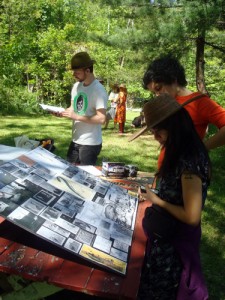 On May 15th 2010, Peter Lamborn Wilson, known to many as Hakim Bey, completed another happening in a series of events aimed at re-enchanting the landscape of forgotten or not-yet-revealed sacred places in upstate New York. These acts of “Endarkenment,” a term Peter uses to mean “fear & respect as well as love for Nature,” are the culmination of his last ten years of research in Ulster County and the surrounding areas. He’s putting the magick he dug up back into the land.
Peter has called this a “temporary landscape installation piece.” It is art that disappears and defies a fetishized place on the
On May 15th 2010, Peter Lamborn Wilson, known to many as Hakim Bey, completed another happening in a series of events aimed at re-enchanting the landscape of forgotten or not-yet-revealed sacred places in upstate New York. These acts of “Endarkenment,” a term Peter uses to mean “fear & respect as well as love for Nature,” are the culmination of his last ten years of research in Ulster County and the surrounding areas. He’s putting the magick he dug up back into the land.
Peter has called this a “temporary landscape installation piece.” It is art that disappears and defies a fetishized place on the 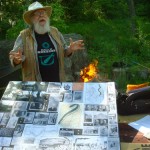 gallery wall. While it bears a resemblance to landscape art, it is more than that, for its goal is to enact the magick of enchantment on the land where each work is performed. The documentation of each of these works includes a hand-written essay, and this May 15th working also featured a large storyboard with pictures and photographs significant to the occasion.
After Peter’s short talk about his research leading up to this event, a few helpers went ahead to make preparations, followed by Peter and his large box labeled “Jukes.” Slowly, the rest of us followed in single file along the narrow towpath where mules used to tread, hauling boats, when the Delaware and Hudson Canal was operational.
gallery wall. While it bears a resemblance to landscape art, it is more than that, for its goal is to enact the magick of enchantment on the land where each work is performed. The documentation of each of these works includes a hand-written essay, and this May 15th working also featured a large storyboard with pictures and photographs significant to the occasion.
After Peter’s short talk about his research leading up to this event, a few helpers went ahead to make preparations, followed by Peter and his large box labeled “Jukes.” Slowly, the rest of us followed in single file along the narrow towpath where mules used to tread, hauling boats, when the Delaware and Hudson Canal was operational.
 In my understanding of it, there were three main groups called forth for reawakening in this work:
one group that has already disappeared, one that is disappearing, and one that now returns.
The group that has already disappeared is known as the Jukes, or at least that’s the name that flawed social scientists gave to this now infamous community of families when they were the target of eugenics studies in the 1800’s. The flaws in these studies have since been recognized, but what still remains fascinating about the Jukes is the reason that they were targeted for such studies to begin with: they were what Peter calls, “a drop-out society,” not unlike the modern day Ramapough Mountain Indians from New Jersey, who were the subject of the recent New Yorker article “Strangers on the Mountain.” But the Ramapough Mountain Indians,
In my understanding of it, there were three main groups called forth for reawakening in this work:
one group that has already disappeared, one that is disappearing, and one that now returns.
The group that has already disappeared is known as the Jukes, or at least that’s the name that flawed social scientists gave to this now infamous community of families when they were the target of eugenics studies in the 1800’s. The flaws in these studies have since been recognized, but what still remains fascinating about the Jukes is the reason that they were targeted for such studies to begin with: they were what Peter calls, “a drop-out society,” not unlike the modern day Ramapough Mountain Indians from New Jersey, who were the subject of the recent New Yorker article “Strangers on the Mountain.” But the Ramapough Mountain Indians, 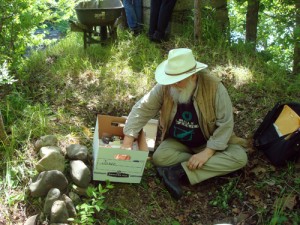 or “Jackson Whites,” as they have been called, have kept their society, even with the skyscrapers of New York threatening on the horizon. They have also kept their mountain - even with the enduring effects of the toxic waste that the old Ford factory dumped on it decades before. The Jukes have not been so lucky – if you can call it luck. While descendants of the Jukes surely still exist, their isolated drop-out community has vanished, and they seem a distant legend in the Ulster County of 2010. All that remains of the Jukes today can be found in a poorhouse graveyard in New Paltz that was re-discovered in 2001, and in the records kept by the poorhouse and those in the archives of the SUNY Albany library. The once vibrant living community of Jukes has now vanished.
or “Jackson Whites,” as they have been called, have kept their society, even with the skyscrapers of New York threatening on the horizon. They have also kept their mountain - even with the enduring effects of the toxic waste that the old Ford factory dumped on it decades before. The Jukes have not been so lucky – if you can call it luck. While descendants of the Jukes surely still exist, their isolated drop-out community has vanished, and they seem a distant legend in the Ulster County of 2010. All that remains of the Jukes today can be found in a poorhouse graveyard in New Paltz that was re-discovered in 2001, and in the records kept by the poorhouse and those in the archives of the SUNY Albany library. The once vibrant living community of Jukes has now vanished.
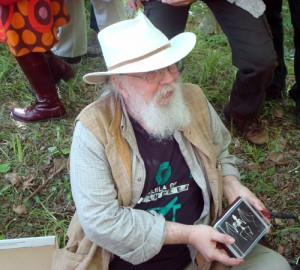 The second group, the group that is in the process of vanishing, is the bat community. All along the East Coast and into the Midwest, bats have been found dead in the hundreds of thousands.
The second group, the group that is in the process of vanishing, is the bat community. All along the East Coast and into the Midwest, bats have been found dead in the hundreds of thousands. 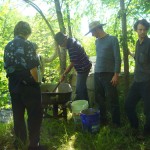 The bats are dying of “white-nose syndrome,” so named for the white fungus, Geomyces destructans, that can be seen on the muzzles of infected bats. It is still uncertain whether the fungus is the disease or whether it is able to take hold of an immune system already weakened by some other disease, though it seems that the fungus itself is the culprit. Bats are a major predator to insects, not just the insects that interfere with us on a hot summer day, but also those that interfere with the growth of crops. The threat of imbalance in the ecosystem, as well as the possibility of extinction for many species of bats, is a serious concern for us all as we watch this community of animals suddenly disappear.
The bats are dying of “white-nose syndrome,” so named for the white fungus, Geomyces destructans, that can be seen on the muzzles of infected bats. It is still uncertain whether the fungus is the disease or whether it is able to take hold of an immune system already weakened by some other disease, though it seems that the fungus itself is the culprit. Bats are a major predator to insects, not just the insects that interfere with us on a hot summer day, but also those that interfere with the growth of crops. The threat of imbalance in the ecosystem, as well as the possibility of extinction for many species of bats, is a serious concern for us all as we watch this community of animals suddenly disappear. 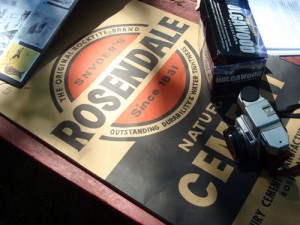 The last group, the one that returns, is the cement itself, which was to be the bonding agent of all that went into this day’s working of Endarkenment. Standing on the aqueduct bridge abutment designed by Roebling in 1850 and overlooking the Rondout Creek, it seemed only fitting that the cement used for this occasion should be Rosendale Natural Cement, which was the business that founded the nearby town of Rosendale during the construction of the Delaware and Hudson Canal. The cement was first discovered in Rosendale during the excavation of the canal bed for the D & H Canal in 1825, and would later be used as one of the materials in the building of the canal itself. Rosendale Natural Cement was also used in the construction of Roebling’s aqueduct bridge, the remaining abutment on which we then stood, and in his later and more famous project, the Brooklyn Bridge. Despite the popularity of Rosendale Cement in the nineteenth century, the introduction of faster-setting Portland Cement meant the end of natural cement production in the twentieth century. By 1970, the last of the cement mines in Rosendale were closed. Natural cement was no longer available.
But in 2004, natural cement made a surprising return when Edison Coatings, Inc decided to resurrect production of Rosendale Natural Cement. The main reason behind this comeback was the need to restore buildings and monuments that were originally constructed using natural cement,
The last group, the one that returns, is the cement itself, which was to be the bonding agent of all that went into this day’s working of Endarkenment. Standing on the aqueduct bridge abutment designed by Roebling in 1850 and overlooking the Rondout Creek, it seemed only fitting that the cement used for this occasion should be Rosendale Natural Cement, which was the business that founded the nearby town of Rosendale during the construction of the Delaware and Hudson Canal. The cement was first discovered in Rosendale during the excavation of the canal bed for the D & H Canal in 1825, and would later be used as one of the materials in the building of the canal itself. Rosendale Natural Cement was also used in the construction of Roebling’s aqueduct bridge, the remaining abutment on which we then stood, and in his later and more famous project, the Brooklyn Bridge. Despite the popularity of Rosendale Cement in the nineteenth century, the introduction of faster-setting Portland Cement meant the end of natural cement production in the twentieth century. By 1970, the last of the cement mines in Rosendale were closed. Natural cement was no longer available.
But in 2004, natural cement made a surprising return when Edison Coatings, Inc decided to resurrect production of Rosendale Natural Cement. The main reason behind this comeback was the need to restore buildings and monuments that were originally constructed using natural cement,  though it turns out that Rosendale Natural Cement is actually “greener” than modern Portland Cement. Due to its much lower firing temperatures and the ease of grinding, natural cement requires less energy to produce.
As we gathered around Peter to watch this artwork in its vanishing, an artwork that is being done for those who vanish, the scent of copal mixed with other incenses - those he had burning on the rock before us, and those of the forest itself.
though it turns out that Rosendale Natural Cement is actually “greener” than modern Portland Cement. Due to its much lower firing temperatures and the ease of grinding, natural cement requires less energy to produce.
As we gathered around Peter to watch this artwork in its vanishing, an artwork that is being done for those who vanish, the scent of copal mixed with other incenses - those he had burning on the rock before us, and those of the forest itself.
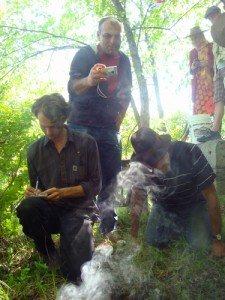 The artwork happened simply. There was little ceremony, perhaps to the confusion of some in attendance who had hoped for a chant or a reading. Peter presented items, one by one, and placed them into a hole in the ground that would be filled with cement. Among these were crystals, a fancy bat skeleton from Carolina Biological, the remains of the incense itself…it made me wonder: must things be buried that they may return? Do we re-enchant our environment when we return to the point zero?
For Peter’s magickal purposes in this act of art, I believe it was significant that the natural cement local to this area, the one element in the work that had gone from a state of disappearance into new life, should be the bonding agent for all the others. As the creation of this temporary installation piece was executed, we watched closely as items disappeared into the hole, as their physical passage from the box labeled “Jukes” into the hole before us disappeared into memory. All of this was then sealed by cement and rocks found around the site the day before. While the process of art may have vanished, the evidence of the act endures. Like the Brooklyn Bridge, the pedestal of the Statue of Liberty, and Grand Central Terminal, this momentary work was made using Rosendale Natural Cement. Its purpose is beyond that of a monument, but the place of Endarkenment was built to last just the same, even if it was now only visible to the spirits, as Peter says.
The artwork happened simply. There was little ceremony, perhaps to the confusion of some in attendance who had hoped for a chant or a reading. Peter presented items, one by one, and placed them into a hole in the ground that would be filled with cement. Among these were crystals, a fancy bat skeleton from Carolina Biological, the remains of the incense itself…it made me wonder: must things be buried that they may return? Do we re-enchant our environment when we return to the point zero?
For Peter’s magickal purposes in this act of art, I believe it was significant that the natural cement local to this area, the one element in the work that had gone from a state of disappearance into new life, should be the bonding agent for all the others. As the creation of this temporary installation piece was executed, we watched closely as items disappeared into the hole, as their physical passage from the box labeled “Jukes” into the hole before us disappeared into memory. All of this was then sealed by cement and rocks found around the site the day before. While the process of art may have vanished, the evidence of the act endures. Like the Brooklyn Bridge, the pedestal of the Statue of Liberty, and Grand Central Terminal, this momentary work was made using Rosendale Natural Cement. Its purpose is beyond that of a monument, but the place of Endarkenment was built to last just the same, even if it was now only visible to the spirits, as Peter says.
 After we traveled back along the narrow towpath and out of the woods, a little boy who was playing pointed up to the sky, and we all saw it: a small rainbow showing itself faintly through the trees, though it hadn’t rained at all. The enchantment was complete, and the signs of this were not only visible to the spirits, but also to us.
*** Peter's statements that have been quoted here are from the press release of a previous related event. You can read his writing on that event here:
http://www.sevenpillarshouse.org/article/first_vanishing_art/
After we traveled back along the narrow towpath and out of the woods, a little boy who was playing pointed up to the sky, and we all saw it: a small rainbow showing itself faintly through the trees, though it hadn’t rained at all. The enchantment was complete, and the signs of this were not only visible to the spirits, but also to us.
*** Peter's statements that have been quoted here are from the press release of a previous related event. You can read his writing on that event here:
http://www.sevenpillarshouse.org/article/first_vanishing_art/
 7VPZM2AUKGJM
7VPZM2AUKGJM
 Our Buried Children
Our Buried Children
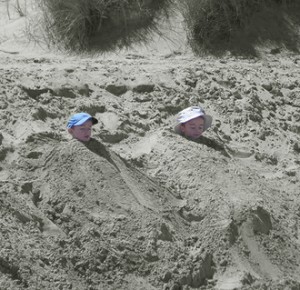 by Ayesha Adamo
This entry is in reference to the recent New York Times article "Placing the Blame as Students Are Buried in Debt." Read it here:
http://www.nytimes.com/2010/05/29/your-money/student-loans/29money.html
I am re-posting what I wrote as a comment to this article, not so much in response to the article itself, but in response to the many surprisingly negative comments that it garnered on the web. Here is a link to the comments left on the NYTimes website, though more colourful/less intelligent commentary can be found on various sites all over the net.
http://community.nytimes.com/comments/bucks.blogs.nytimes.com/2010/05/28/assigning-responsibility-for-high-student-loan-debts/?sort=newest
This is what I wrote:
Wow. The response to this article - here and elsewhere on the web - is astonishing...and not in a good way.
Many here are hostile to the idea of a financially challenged girl choosing a liberal arts major – in this case, Religion and Women’s Studies – though I can only imagine the response if this girl had a major like mine: Music! God - the Arts! How worthless to humanity! (but if you think so, I’m wondering right about now why on earth you’re reading the New York Times website instead of the Fox News website. I’m just saying…)
The question raised by this hostility is actually a question of whether there should be an open-ended list of possible majors for the rich kids and a different list presented to the poor kids, and likewise, a list of possible colleges and universities for the rich, and those for the poor.
It’s easy to be libertarian about material things – about buying the car you can afford, the house with a mortgage you can pay off (though I’d live in the woods before engaging in a mortgage. Notice the “mort” part of mortgage? It means death, folks.).
But to be a libertarian about an education? To suggest that access to the best professors and resources is limited to those who can afford those relationships, experiences, and opportunities for intellectual growth – opportunities that come even more from the environment than from what a book can tell?
The American dream may be dead, but we further desecrate the corpse when we are forced to tell our children that they’re limited to the possibilities dictated by their caste. Anyone who has truly embraced the experience that is education knows that it’s more than the purchase of a fancy name on a diploma.
An education is NOT a material thing. It’s a thing that has the power to change a person and, in turn, change the world.
To the people posting comments with no empathy for the students now buried in debt: don’t you look at your brilliant and hard-working kids and ask, “Doesn’t my daughter/son deserve the same stimulating education that the kid with his name on the building gets? And why should my kid have to do so much more to get it?”
Saying that “the world ain’t fair” isn’t an answer. With that kind of complacency, we’d still be in the dark ages of segregation and the like.
Education should be given to those who can use it and who can take it as far as it can go. It should never be a matter of having a relative’s name on a building, in other words, a matter of financial class. To think otherwise is to tell your kids to accept their serfdom - a very sad prospect, indeed.
Whether or not there are amazing state schools, which there are, really isn’t the point. The point is that the currency of the intellect should not be measured in Federal Reserve Notes, or gold, or in the willingness to wager your life against your tuition in a time of war. Education is too noble a thing to be measured in blood or gold or worthless shards of the most lacerating paper.
Perhaps our author, Ron Lieber, could have chosen a splashier subject for his article – maybe an über-genius middle class gal at an Ivy doing a degree in social work and catching a flight to the UAE to pay off her tuition using the oldest means there is, something she never had in mind. (It exists, people, more than you think.) Maybe then those who lack empathy for these, our buried children, would finally understand what’s really going on here – maybe then they’d understand the lengths that people must go to in order to develop their gifts to the level that those gifts deserve – really to the level that we all deserve, for we all benefit when people come into the world making the absolute most of their gifts.
by Ayesha Adamo
This entry is in reference to the recent New York Times article "Placing the Blame as Students Are Buried in Debt." Read it here:
http://www.nytimes.com/2010/05/29/your-money/student-loans/29money.html
I am re-posting what I wrote as a comment to this article, not so much in response to the article itself, but in response to the many surprisingly negative comments that it garnered on the web. Here is a link to the comments left on the NYTimes website, though more colourful/less intelligent commentary can be found on various sites all over the net.
http://community.nytimes.com/comments/bucks.blogs.nytimes.com/2010/05/28/assigning-responsibility-for-high-student-loan-debts/?sort=newest
This is what I wrote:
Wow. The response to this article - here and elsewhere on the web - is astonishing...and not in a good way.
Many here are hostile to the idea of a financially challenged girl choosing a liberal arts major – in this case, Religion and Women’s Studies – though I can only imagine the response if this girl had a major like mine: Music! God - the Arts! How worthless to humanity! (but if you think so, I’m wondering right about now why on earth you’re reading the New York Times website instead of the Fox News website. I’m just saying…)
The question raised by this hostility is actually a question of whether there should be an open-ended list of possible majors for the rich kids and a different list presented to the poor kids, and likewise, a list of possible colleges and universities for the rich, and those for the poor.
It’s easy to be libertarian about material things – about buying the car you can afford, the house with a mortgage you can pay off (though I’d live in the woods before engaging in a mortgage. Notice the “mort” part of mortgage? It means death, folks.).
But to be a libertarian about an education? To suggest that access to the best professors and resources is limited to those who can afford those relationships, experiences, and opportunities for intellectual growth – opportunities that come even more from the environment than from what a book can tell?
The American dream may be dead, but we further desecrate the corpse when we are forced to tell our children that they’re limited to the possibilities dictated by their caste. Anyone who has truly embraced the experience that is education knows that it’s more than the purchase of a fancy name on a diploma.
An education is NOT a material thing. It’s a thing that has the power to change a person and, in turn, change the world.
To the people posting comments with no empathy for the students now buried in debt: don’t you look at your brilliant and hard-working kids and ask, “Doesn’t my daughter/son deserve the same stimulating education that the kid with his name on the building gets? And why should my kid have to do so much more to get it?”
Saying that “the world ain’t fair” isn’t an answer. With that kind of complacency, we’d still be in the dark ages of segregation and the like.
Education should be given to those who can use it and who can take it as far as it can go. It should never be a matter of having a relative’s name on a building, in other words, a matter of financial class. To think otherwise is to tell your kids to accept their serfdom - a very sad prospect, indeed.
Whether or not there are amazing state schools, which there are, really isn’t the point. The point is that the currency of the intellect should not be measured in Federal Reserve Notes, or gold, or in the willingness to wager your life against your tuition in a time of war. Education is too noble a thing to be measured in blood or gold or worthless shards of the most lacerating paper.
Perhaps our author, Ron Lieber, could have chosen a splashier subject for his article – maybe an über-genius middle class gal at an Ivy doing a degree in social work and catching a flight to the UAE to pay off her tuition using the oldest means there is, something she never had in mind. (It exists, people, more than you think.) Maybe then those who lack empathy for these, our buried children, would finally understand what’s really going on here – maybe then they’d understand the lengths that people must go to in order to develop their gifts to the level that those gifts deserve – really to the level that we all deserve, for we all benefit when people come into the world making the absolute most of their gifts.
 Flamethrower Magazine Interview!
Flamethrower Magazine Interview!
 So, CJ at Flamethrower Magazine just posted this fantastic interview of us (you know, Loss of Eden) - with probably the most igniting and thoughtful interview questions ever. Find out things you never knew!...Like how we came up with the idea of doing naked Youtube cover songs and why we write more on our blog than just some upcoming tour dates or other self-aggrandizing stuff like that. Check it out at:
http://www.flamethrowermagazine.com/
And be prepared for a pop quiz on the assigned material. 😉
So, CJ at Flamethrower Magazine just posted this fantastic interview of us (you know, Loss of Eden) - with probably the most igniting and thoughtful interview questions ever. Find out things you never knew!...Like how we came up with the idea of doing naked Youtube cover songs and why we write more on our blog than just some upcoming tour dates or other self-aggrandizing stuff like that. Check it out at:
http://www.flamethrowermagazine.com/
And be prepared for a pop quiz on the assigned material. 😉
 Performing tomorrow, 5/30, in Union Square!
Performing tomorrow, 5/30, in Union Square!
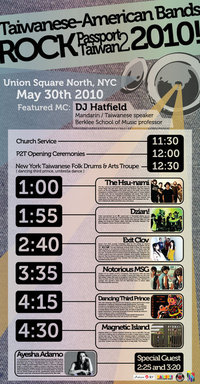 Just singing a couple of songs in Union Square tomorrow afternoon. I'll be doing a Chinese song and a Loss of Eden song. The event is called Passport 2 Taiwan and is a part of Taiwanese American Heritage Week in NYC, and Asian Pacific Heritage month. You can find out more at the event's website or at the facebook event page:
http://p2tw.org/
http://www.facebook.com/event.php?eid=333293782154&ref=ts
Or just show up! I'm going to be doing one song at 2:25, and one at 3:20, according to the schedule, which appears to be very precise. Would love to see you there!
Just singing a couple of songs in Union Square tomorrow afternoon. I'll be doing a Chinese song and a Loss of Eden song. The event is called Passport 2 Taiwan and is a part of Taiwanese American Heritage Week in NYC, and Asian Pacific Heritage month. You can find out more at the event's website or at the facebook event page:
http://p2tw.org/
http://www.facebook.com/event.php?eid=333293782154&ref=ts
Or just show up! I'm going to be doing one song at 2:25, and one at 3:20, according to the schedule, which appears to be very precise. Would love to see you there!
 Loss of Eden Reviewed on IndieRockMagazine.com
Loss of Eden Reviewed on IndieRockMagazine.com
Look what a little internet searching turned up: This great review of our EP from Indie Rock Magazine!
 LOSS OF EDEN Pure sadness lingers in New York City. Loss Of Eden, is an unsigned folk rock/pop band that is heavily influenced by The Carpenters and folk legend Joan Baez. This is true with the "gut wrenching" track "Worlds Away" released on January 1, 2009. A heartbreaking tale about a couple on the verge of a breakup. A woman wants her boyfriend to communicate with her. However, her boyfriend remains distant. This track features soulful vocals and light rock guitar riffs. These features add to the mellow nature of the song. Loss Of Eden's style of folk rock and pop is light and refreshing! Leslie Snyder
Check out: http://indierockmagazine.com/press.html (we're down in the reviews for April)
LOSS OF EDEN Pure sadness lingers in New York City. Loss Of Eden, is an unsigned folk rock/pop band that is heavily influenced by The Carpenters and folk legend Joan Baez. This is true with the "gut wrenching" track "Worlds Away" released on January 1, 2009. A heartbreaking tale about a couple on the verge of a breakup. A woman wants her boyfriend to communicate with her. However, her boyfriend remains distant. This track features soulful vocals and light rock guitar riffs. These features add to the mellow nature of the song. Loss Of Eden's style of folk rock and pop is light and refreshing! Leslie Snyder
Check out: http://indierockmagazine.com/press.html (we're down in the reviews for April)
 LOSS OF EDEN Pure sadness lingers in New York City. Loss Of Eden, is an unsigned folk rock/pop band that is heavily influenced by The Carpenters and folk legend Joan Baez. This is true with the "gut wrenching" track "Worlds Away" released on January 1, 2009. A heartbreaking tale about a couple on the verge of a breakup. A woman wants her boyfriend to communicate with her. However, her boyfriend remains distant. This track features soulful vocals and light rock guitar riffs. These features add to the mellow nature of the song. Loss Of Eden's style of folk rock and pop is light and refreshing! Leslie Snyder
Check out: http://indierockmagazine.com/press.html (we're down in the reviews for April)
LOSS OF EDEN Pure sadness lingers in New York City. Loss Of Eden, is an unsigned folk rock/pop band that is heavily influenced by The Carpenters and folk legend Joan Baez. This is true with the "gut wrenching" track "Worlds Away" released on January 1, 2009. A heartbreaking tale about a couple on the verge of a breakup. A woman wants her boyfriend to communicate with her. However, her boyfriend remains distant. This track features soulful vocals and light rock guitar riffs. These features add to the mellow nature of the song. Loss Of Eden's style of folk rock and pop is light and refreshing! Leslie Snyder
Check out: http://indierockmagazine.com/press.html (we're down in the reviews for April)
 Spargel, Fish, and Farewells
Spargel, Fish, and Farewells
by Ayesha Adamo
 It seemed that the moment my plane landed in Berlin, Spargel season had officially begun. There was hardly a restaurant in the city that wasn’t offering some sort of Spargel-special, four courses of Spargel…even dessert. I had
It seemed that the moment my plane landed in Berlin, Spargel season had officially begun. There was hardly a restaurant in the city that wasn’t offering some sort of Spargel-special, four courses of Spargel…even dessert. I had  never heard of Spargel before, but I learned pretty quick. Spargel is this thick white asparagus that Germans seem to go crazy for, especially because it’s only available for two weeks out of the entire year. It’s a little bit phallic looking, and maybe that’s part of the charm, too. You can see piles of it here, in this photo I took at the Turkish market in Kotti:
never heard of Spargel before, but I learned pretty quick. Spargel is this thick white asparagus that Germans seem to go crazy for, especially because it’s only available for two weeks out of the entire year. It’s a little bit phallic looking, and maybe that’s part of the charm, too. You can see piles of it here, in this photo I took at the Turkish market in Kotti:  The fantastic deli, “Rogacki,” where I got my first taste of Berlin, was no exception to the rule of Spargel either.
Rogacki is the deli to end all delis. I mean, I used to deeply mourn the loss of Second Avenue Deli down in the East Village after it lost the rent war to a Chase Bank branch (which I suppose is exactly what all those yuppies that have taken over the neighborhood deserve anyway), but Rogacki is in a whole other class.
The fantastic deli, “Rogacki,” where I got my first taste of Berlin, was no exception to the rule of Spargel either.
Rogacki is the deli to end all delis. I mean, I used to deeply mourn the loss of Second Avenue Deli down in the East Village after it lost the rent war to a Chase Bank branch (which I suppose is exactly what all those yuppies that have taken over the neighborhood deserve anyway), but Rogacki is in a whole other class.  Rogacki is in Charlottenburg on Wilmersdorfer Strasse, just half a block from the Bismarckstrasse U-bahn. Everyone stands at the counter to eat, though there were a few
Rogacki is in Charlottenburg on Wilmersdorfer Strasse, just half a block from the Bismarckstrasse U-bahn. Everyone stands at the counter to eat, though there were a few  tables out front in recognition of the spring weather.
In addition to the seemingly endless window cases of beautiful sausages and deli meats, this place has some serious fish
tables out front in recognition of the spring weather.
In addition to the seemingly endless window cases of beautiful sausages and deli meats, this place has some serious fish  (the big guy with the sad look on his face at the top of this article is also a Rogacki resident). We ate the most amazing fish soup and grilled fish with vegetables, all prepared by the no-nonsense ladies at the counter before our eyes. In keeping with the reputation
(the big guy with the sad look on his face at the top of this article is also a Rogacki resident). We ate the most amazing fish soup and grilled fish with vegetables, all prepared by the no-nonsense ladies at the counter before our eyes. In keeping with the reputation  of this family-run business that started in 1928 selling fish exclusively, they still smoke their own fish and eel on site here. But nowadays, there’s also fresh turkey,
of this family-run business that started in 1928 selling fish exclusively, they still smoke their own fish and eel on site here. But nowadays, there’s also fresh turkey, 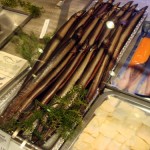 venison, duck and on and on…
http://rogacki.de/ro/roga.htm
In general, Berlin is a great place for fish and seafood, and my last night’s dinner at the amazing Turkish-run Fisch Restaurant was the perfect bookend to my Rogacki experience.
Balikci Ergün is on Lüneburger Strasse under the S-Bahn, across the Spree and not so far from Bellevue Station. You will know it by the blue and yellow sign saying “Fisch Restaurant.”
venison, duck and on and on…
http://rogacki.de/ro/roga.htm
In general, Berlin is a great place for fish and seafood, and my last night’s dinner at the amazing Turkish-run Fisch Restaurant was the perfect bookend to my Rogacki experience.
Balikci Ergün is on Lüneburger Strasse under the S-Bahn, across the Spree and not so far from Bellevue Station. You will know it by the blue and yellow sign saying “Fisch Restaurant.”
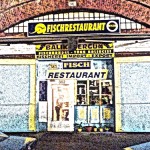 I’m pretty sure that the entrance on Lüneburger Strasse is a back entrance devoted to their fish distribution business, but after a few moments of confusion and seeing what was behind door number one, two and three, I eventually found my way into the restaurant.
This last night was a night to say goodbye to Berlin, and to Maria Thereza Alves and Jimmie Durham, whose three exhibits during gallery weekend and talk at the House for World Culture with Mick Taussig were an important part of my visit.
The conversation at our table twisted and turned into and out of politics and Art, Europe and the Americas. For the struggling and flailing artist that I am, it was fascinating to hear about how someone with a career as enduring as Jimmie’s would repeatedly turn down the opportunity to have a PBS documentary done on his life and work, responding that this sort of documentary kills the artwork, and the artist who made it, every time. I guess it’s the reaction I would expect from the man who’s just displayed a gallery of modern-art-stuffed-mooseheads (like what you'd see in a fancy hunting lodge, except this was Art - not taxidermy). It's hopeful to see someone cleverly poking fun at the bourgeois trophies that great works of Art have become – or always were, perhaps. But for a young creative who’s tired of trying to reinvent her Art’s PR campaign on a weekly basis, and who enters a state of nearly-epileptic joy anytime some stranger deigns to add a thumbs-up “like” to her latest facebook post, the idea of turning down a documentary makes the eyes a little moist…a little moist. I get it, though.
I’m pretty sure that the entrance on Lüneburger Strasse is a back entrance devoted to their fish distribution business, but after a few moments of confusion and seeing what was behind door number one, two and three, I eventually found my way into the restaurant.
This last night was a night to say goodbye to Berlin, and to Maria Thereza Alves and Jimmie Durham, whose three exhibits during gallery weekend and talk at the House for World Culture with Mick Taussig were an important part of my visit.
The conversation at our table twisted and turned into and out of politics and Art, Europe and the Americas. For the struggling and flailing artist that I am, it was fascinating to hear about how someone with a career as enduring as Jimmie’s would repeatedly turn down the opportunity to have a PBS documentary done on his life and work, responding that this sort of documentary kills the artwork, and the artist who made it, every time. I guess it’s the reaction I would expect from the man who’s just displayed a gallery of modern-art-stuffed-mooseheads (like what you'd see in a fancy hunting lodge, except this was Art - not taxidermy). It's hopeful to see someone cleverly poking fun at the bourgeois trophies that great works of Art have become – or always were, perhaps. But for a young creative who’s tired of trying to reinvent her Art’s PR campaign on a weekly basis, and who enters a state of nearly-epileptic joy anytime some stranger deigns to add a thumbs-up “like” to her latest facebook post, the idea of turning down a documentary makes the eyes a little moist…a little moist. I get it, though.
 But to get back to the food...Jimmie and Maria Thereza were regulars at the Fisch Restaurant when they lived in Berlin. This secret little gem of a place was opened by a former World Cup soccer star who played for Turkey, and the walls show photos of his soccer days, while hundreds of cards from fans of his fish hang from the ceiling. The menu features photographs of the different fish you can order, most of them sharing camera time with a tall can of beer, not to make a beverage suggestion, but to help indicate the size of the fish. I had a plate full of the tasty little red ones.
In the later hours, strong coffee and friendly shots of anise liquor circulated, as a couple of tables of smartly dressed Turkish men talked seriously over swirling tendrils of shisha that danced in the low yellow light, disappearing like the hours before my plane ride home.
But to get back to the food...Jimmie and Maria Thereza were regulars at the Fisch Restaurant when they lived in Berlin. This secret little gem of a place was opened by a former World Cup soccer star who played for Turkey, and the walls show photos of his soccer days, while hundreds of cards from fans of his fish hang from the ceiling. The menu features photographs of the different fish you can order, most of them sharing camera time with a tall can of beer, not to make a beverage suggestion, but to help indicate the size of the fish. I had a plate full of the tasty little red ones.
In the later hours, strong coffee and friendly shots of anise liquor circulated, as a couple of tables of smartly dressed Turkish men talked seriously over swirling tendrils of shisha that danced in the low yellow light, disappearing like the hours before my plane ride home.
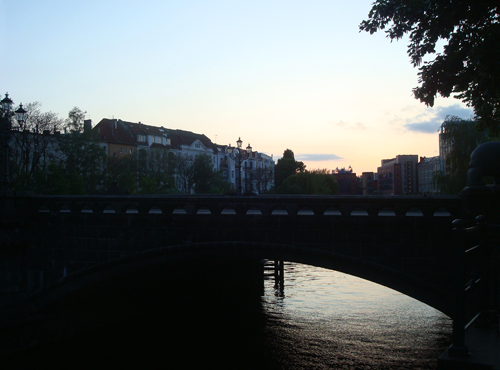
 It seemed that the moment my plane landed in Berlin, Spargel season had officially begun. There was hardly a restaurant in the city that wasn’t offering some sort of Spargel-special, four courses of Spargel…even dessert. I had
It seemed that the moment my plane landed in Berlin, Spargel season had officially begun. There was hardly a restaurant in the city that wasn’t offering some sort of Spargel-special, four courses of Spargel…even dessert. I had  never heard of Spargel before, but I learned pretty quick. Spargel is this thick white asparagus that Germans seem to go crazy for, especially because it’s only available for two weeks out of the entire year. It’s a little bit phallic looking, and maybe that’s part of the charm, too. You can see piles of it here, in this photo I took at the Turkish market in Kotti:
never heard of Spargel before, but I learned pretty quick. Spargel is this thick white asparagus that Germans seem to go crazy for, especially because it’s only available for two weeks out of the entire year. It’s a little bit phallic looking, and maybe that’s part of the charm, too. You can see piles of it here, in this photo I took at the Turkish market in Kotti:  The fantastic deli, “Rogacki,” where I got my first taste of Berlin, was no exception to the rule of Spargel either.
Rogacki is the deli to end all delis. I mean, I used to deeply mourn the loss of Second Avenue Deli down in the East Village after it lost the rent war to a Chase Bank branch (which I suppose is exactly what all those yuppies that have taken over the neighborhood deserve anyway), but Rogacki is in a whole other class.
The fantastic deli, “Rogacki,” where I got my first taste of Berlin, was no exception to the rule of Spargel either.
Rogacki is the deli to end all delis. I mean, I used to deeply mourn the loss of Second Avenue Deli down in the East Village after it lost the rent war to a Chase Bank branch (which I suppose is exactly what all those yuppies that have taken over the neighborhood deserve anyway), but Rogacki is in a whole other class.  Rogacki is in Charlottenburg on Wilmersdorfer Strasse, just half a block from the Bismarckstrasse U-bahn. Everyone stands at the counter to eat, though there were a few
Rogacki is in Charlottenburg on Wilmersdorfer Strasse, just half a block from the Bismarckstrasse U-bahn. Everyone stands at the counter to eat, though there were a few  tables out front in recognition of the spring weather.
In addition to the seemingly endless window cases of beautiful sausages and deli meats, this place has some serious fish
tables out front in recognition of the spring weather.
In addition to the seemingly endless window cases of beautiful sausages and deli meats, this place has some serious fish  (the big guy with the sad look on his face at the top of this article is also a Rogacki resident). We ate the most amazing fish soup and grilled fish with vegetables, all prepared by the no-nonsense ladies at the counter before our eyes. In keeping with the reputation
(the big guy with the sad look on his face at the top of this article is also a Rogacki resident). We ate the most amazing fish soup and grilled fish with vegetables, all prepared by the no-nonsense ladies at the counter before our eyes. In keeping with the reputation  of this family-run business that started in 1928 selling fish exclusively, they still smoke their own fish and eel on site here. But nowadays, there’s also fresh turkey,
of this family-run business that started in 1928 selling fish exclusively, they still smoke their own fish and eel on site here. But nowadays, there’s also fresh turkey,  venison, duck and on and on…
http://rogacki.de/ro/roga.htm
In general, Berlin is a great place for fish and seafood, and my last night’s dinner at the amazing Turkish-run Fisch Restaurant was the perfect bookend to my Rogacki experience.
Balikci Ergün is on Lüneburger Strasse under the S-Bahn, across the Spree and not so far from Bellevue Station. You will know it by the blue and yellow sign saying “Fisch Restaurant.”
venison, duck and on and on…
http://rogacki.de/ro/roga.htm
In general, Berlin is a great place for fish and seafood, and my last night’s dinner at the amazing Turkish-run Fisch Restaurant was the perfect bookend to my Rogacki experience.
Balikci Ergün is on Lüneburger Strasse under the S-Bahn, across the Spree and not so far from Bellevue Station. You will know it by the blue and yellow sign saying “Fisch Restaurant.”
 I’m pretty sure that the entrance on Lüneburger Strasse is a back entrance devoted to their fish distribution business, but after a few moments of confusion and seeing what was behind door number one, two and three, I eventually found my way into the restaurant.
This last night was a night to say goodbye to Berlin, and to Maria Thereza Alves and Jimmie Durham, whose three exhibits during gallery weekend and talk at the House for World Culture with Mick Taussig were an important part of my visit.
The conversation at our table twisted and turned into and out of politics and Art, Europe and the Americas. For the struggling and flailing artist that I am, it was fascinating to hear about how someone with a career as enduring as Jimmie’s would repeatedly turn down the opportunity to have a PBS documentary done on his life and work, responding that this sort of documentary kills the artwork, and the artist who made it, every time. I guess it’s the reaction I would expect from the man who’s just displayed a gallery of modern-art-stuffed-mooseheads (like what you'd see in a fancy hunting lodge, except this was Art - not taxidermy). It's hopeful to see someone cleverly poking fun at the bourgeois trophies that great works of Art have become – or always were, perhaps. But for a young creative who’s tired of trying to reinvent her Art’s PR campaign on a weekly basis, and who enters a state of nearly-epileptic joy anytime some stranger deigns to add a thumbs-up “like” to her latest facebook post, the idea of turning down a documentary makes the eyes a little moist…a little moist. I get it, though.
I’m pretty sure that the entrance on Lüneburger Strasse is a back entrance devoted to their fish distribution business, but after a few moments of confusion and seeing what was behind door number one, two and three, I eventually found my way into the restaurant.
This last night was a night to say goodbye to Berlin, and to Maria Thereza Alves and Jimmie Durham, whose three exhibits during gallery weekend and talk at the House for World Culture with Mick Taussig were an important part of my visit.
The conversation at our table twisted and turned into and out of politics and Art, Europe and the Americas. For the struggling and flailing artist that I am, it was fascinating to hear about how someone with a career as enduring as Jimmie’s would repeatedly turn down the opportunity to have a PBS documentary done on his life and work, responding that this sort of documentary kills the artwork, and the artist who made it, every time. I guess it’s the reaction I would expect from the man who’s just displayed a gallery of modern-art-stuffed-mooseheads (like what you'd see in a fancy hunting lodge, except this was Art - not taxidermy). It's hopeful to see someone cleverly poking fun at the bourgeois trophies that great works of Art have become – or always were, perhaps. But for a young creative who’s tired of trying to reinvent her Art’s PR campaign on a weekly basis, and who enters a state of nearly-epileptic joy anytime some stranger deigns to add a thumbs-up “like” to her latest facebook post, the idea of turning down a documentary makes the eyes a little moist…a little moist. I get it, though.
 But to get back to the food...Jimmie and Maria Thereza were regulars at the Fisch Restaurant when they lived in Berlin. This secret little gem of a place was opened by a former World Cup soccer star who played for Turkey, and the walls show photos of his soccer days, while hundreds of cards from fans of his fish hang from the ceiling. The menu features photographs of the different fish you can order, most of them sharing camera time with a tall can of beer, not to make a beverage suggestion, but to help indicate the size of the fish. I had a plate full of the tasty little red ones.
In the later hours, strong coffee and friendly shots of anise liquor circulated, as a couple of tables of smartly dressed Turkish men talked seriously over swirling tendrils of shisha that danced in the low yellow light, disappearing like the hours before my plane ride home.
But to get back to the food...Jimmie and Maria Thereza were regulars at the Fisch Restaurant when they lived in Berlin. This secret little gem of a place was opened by a former World Cup soccer star who played for Turkey, and the walls show photos of his soccer days, while hundreds of cards from fans of his fish hang from the ceiling. The menu features photographs of the different fish you can order, most of them sharing camera time with a tall can of beer, not to make a beverage suggestion, but to help indicate the size of the fish. I had a plate full of the tasty little red ones.
In the later hours, strong coffee and friendly shots of anise liquor circulated, as a couple of tables of smartly dressed Turkish men talked seriously over swirling tendrils of shisha that danced in the low yellow light, disappearing like the hours before my plane ride home.

 How I Almost Lost a Lung in the Name of Techno
How I Almost Lost a Lung in the Name of Techno
by Ayesha Adamo
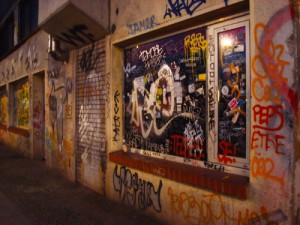 They told me Berghain, Panorama Bar, and an online search admittedly made Watergate and Maria’s sound tempting. But what they didn’t understand was that I can go to a pretentious club with a line out the front - filled with models and yuppie-come-latelies who order bottle service and live to siphon their soulless bodies into fancy suits and stiletto heels (who can dance in that stuff anyway?), albeit to the tune of way shittier music – in my home base town of New York, where the losers wear Prada.
There was no way I was going to Berghain…even though they don’t play top 40 and other sweet sixteen/bar mitzvah soundtracks there like they do in the cipher-of-a-once-great-nightlife-town that is Manhattan. That’s not to say that I needed to help inflate the ego-balloon of the international DJs that I can also hear at the last two worthy dance clubs left in the city-that-used-to-have-a-reason-not-to-sleep either.
I wanted local Berlin, and I was willing to go rogue to get it.
It took some asking around, but eventually I was able to procure a map drawn on a napkin showing how to get to Golden Gate. A subsequent online search back at headquarters (the hotel) turned up a primitive and very basic website, also with a map. X marked a spot near Jannowitzbrücke Station, actually directly across the street from it, and I even managed to excavate a photo of the place – a few hundred square pixels under the train tracks and covered with graffiti: now that’s the kind of nightclub I want to be at.
Naturally, I set out with the hope finding a club that was just a few shades less underground than the place I DJ at in Brooklyn, and this looked like it might be it. I clicked on the links to the myspace pages of the DJs for that night, and was surprised to read “93s to infinity!” at the top of one of the DJ’s pages. A thelemite?!? A sign. This was all I really needed to be 156% sure that I had found the club for me. (You’re only getting that last joke if you’re playing with Magick.)
Showed up at 3 am, which was kind of early, but I didn’t think I’d be able to handle it if I tried for much later, jetlag and all. The door was at the side, but there’s no real way to know that besides luck…and now, by reading my blog. It was also surprisingly quiet, and I wondered if the music had even started yet – it’s hard to hear from the street because the main room is nestled far below at the bottom of a narrow stairwell.
They told me Berghain, Panorama Bar, and an online search admittedly made Watergate and Maria’s sound tempting. But what they didn’t understand was that I can go to a pretentious club with a line out the front - filled with models and yuppie-come-latelies who order bottle service and live to siphon their soulless bodies into fancy suits and stiletto heels (who can dance in that stuff anyway?), albeit to the tune of way shittier music – in my home base town of New York, where the losers wear Prada.
There was no way I was going to Berghain…even though they don’t play top 40 and other sweet sixteen/bar mitzvah soundtracks there like they do in the cipher-of-a-once-great-nightlife-town that is Manhattan. That’s not to say that I needed to help inflate the ego-balloon of the international DJs that I can also hear at the last two worthy dance clubs left in the city-that-used-to-have-a-reason-not-to-sleep either.
I wanted local Berlin, and I was willing to go rogue to get it.
It took some asking around, but eventually I was able to procure a map drawn on a napkin showing how to get to Golden Gate. A subsequent online search back at headquarters (the hotel) turned up a primitive and very basic website, also with a map. X marked a spot near Jannowitzbrücke Station, actually directly across the street from it, and I even managed to excavate a photo of the place – a few hundred square pixels under the train tracks and covered with graffiti: now that’s the kind of nightclub I want to be at.
Naturally, I set out with the hope finding a club that was just a few shades less underground than the place I DJ at in Brooklyn, and this looked like it might be it. I clicked on the links to the myspace pages of the DJs for that night, and was surprised to read “93s to infinity!” at the top of one of the DJ’s pages. A thelemite?!? A sign. This was all I really needed to be 156% sure that I had found the club for me. (You’re only getting that last joke if you’re playing with Magick.)
Showed up at 3 am, which was kind of early, but I didn’t think I’d be able to handle it if I tried for much later, jetlag and all. The door was at the side, but there’s no real way to know that besides luck…and now, by reading my blog. It was also surprisingly quiet, and I wondered if the music had even started yet – it’s hard to hear from the street because the main room is nestled far below at the bottom of a narrow stairwell.
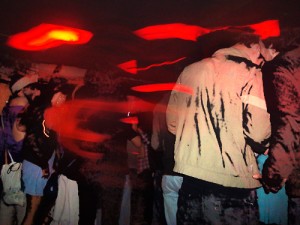 But it sure is loud when you get down there.
And the music! It was like the 1990’s all over again. (I got a little misty eyed). There were dirty sneakers and jeans and cheap beer and bombed out bathroom stalls…heaven. I guess that’s where they got the name Golden Gate.
And the DJs were spinning…could it be? Vinyl?!? Then it really felt like the 90’s all over again. Can’t say I miss dragging around a record box that was double my weight, but compared to New York, it’s nice to see a club that even has turntables. I could see that this place was also equipped with nice CDJs, and what more can a DJ want, really? I mean, besides having the crowd completely entranced and loving it...which they were, myself included.
The only problem was that every person in there was a chain smoker, packed body to rockin’ body in a little black box that was buried underground (literally), and that is how I almost lost a lung in the name of techno.
Sometimes, it’s dangerous goin’ rogue.
When I got back to headquarters, I had to wash my hair 3 times, air out my leather jacket in the window for 2 days, and wrap my dirty clothes in plastic to prevent them from permeating the rest of my luggage with stank. Ah the things we do for love…
http://www.goldengate-berlin.de/html.htm
But it sure is loud when you get down there.
And the music! It was like the 1990’s all over again. (I got a little misty eyed). There were dirty sneakers and jeans and cheap beer and bombed out bathroom stalls…heaven. I guess that’s where they got the name Golden Gate.
And the DJs were spinning…could it be? Vinyl?!? Then it really felt like the 90’s all over again. Can’t say I miss dragging around a record box that was double my weight, but compared to New York, it’s nice to see a club that even has turntables. I could see that this place was also equipped with nice CDJs, and what more can a DJ want, really? I mean, besides having the crowd completely entranced and loving it...which they were, myself included.
The only problem was that every person in there was a chain smoker, packed body to rockin’ body in a little black box that was buried underground (literally), and that is how I almost lost a lung in the name of techno.
Sometimes, it’s dangerous goin’ rogue.
When I got back to headquarters, I had to wash my hair 3 times, air out my leather jacket in the window for 2 days, and wrap my dirty clothes in plastic to prevent them from permeating the rest of my luggage with stank. Ah the things we do for love…
http://www.goldengate-berlin.de/html.htm
 They told me Berghain, Panorama Bar, and an online search admittedly made Watergate and Maria’s sound tempting. But what they didn’t understand was that I can go to a pretentious club with a line out the front - filled with models and yuppie-come-latelies who order bottle service and live to siphon their soulless bodies into fancy suits and stiletto heels (who can dance in that stuff anyway?), albeit to the tune of way shittier music – in my home base town of New York, where the losers wear Prada.
There was no way I was going to Berghain…even though they don’t play top 40 and other sweet sixteen/bar mitzvah soundtracks there like they do in the cipher-of-a-once-great-nightlife-town that is Manhattan. That’s not to say that I needed to help inflate the ego-balloon of the international DJs that I can also hear at the last two worthy dance clubs left in the city-that-used-to-have-a-reason-not-to-sleep either.
I wanted local Berlin, and I was willing to go rogue to get it.
It took some asking around, but eventually I was able to procure a map drawn on a napkin showing how to get to Golden Gate. A subsequent online search back at headquarters (the hotel) turned up a primitive and very basic website, also with a map. X marked a spot near Jannowitzbrücke Station, actually directly across the street from it, and I even managed to excavate a photo of the place – a few hundred square pixels under the train tracks and covered with graffiti: now that’s the kind of nightclub I want to be at.
Naturally, I set out with the hope finding a club that was just a few shades less underground than the place I DJ at in Brooklyn, and this looked like it might be it. I clicked on the links to the myspace pages of the DJs for that night, and was surprised to read “93s to infinity!” at the top of one of the DJ’s pages. A thelemite?!? A sign. This was all I really needed to be 156% sure that I had found the club for me. (You’re only getting that last joke if you’re playing with Magick.)
Showed up at 3 am, which was kind of early, but I didn’t think I’d be able to handle it if I tried for much later, jetlag and all. The door was at the side, but there’s no real way to know that besides luck…and now, by reading my blog. It was also surprisingly quiet, and I wondered if the music had even started yet – it’s hard to hear from the street because the main room is nestled far below at the bottom of a narrow stairwell.
They told me Berghain, Panorama Bar, and an online search admittedly made Watergate and Maria’s sound tempting. But what they didn’t understand was that I can go to a pretentious club with a line out the front - filled with models and yuppie-come-latelies who order bottle service and live to siphon their soulless bodies into fancy suits and stiletto heels (who can dance in that stuff anyway?), albeit to the tune of way shittier music – in my home base town of New York, where the losers wear Prada.
There was no way I was going to Berghain…even though they don’t play top 40 and other sweet sixteen/bar mitzvah soundtracks there like they do in the cipher-of-a-once-great-nightlife-town that is Manhattan. That’s not to say that I needed to help inflate the ego-balloon of the international DJs that I can also hear at the last two worthy dance clubs left in the city-that-used-to-have-a-reason-not-to-sleep either.
I wanted local Berlin, and I was willing to go rogue to get it.
It took some asking around, but eventually I was able to procure a map drawn on a napkin showing how to get to Golden Gate. A subsequent online search back at headquarters (the hotel) turned up a primitive and very basic website, also with a map. X marked a spot near Jannowitzbrücke Station, actually directly across the street from it, and I even managed to excavate a photo of the place – a few hundred square pixels under the train tracks and covered with graffiti: now that’s the kind of nightclub I want to be at.
Naturally, I set out with the hope finding a club that was just a few shades less underground than the place I DJ at in Brooklyn, and this looked like it might be it. I clicked on the links to the myspace pages of the DJs for that night, and was surprised to read “93s to infinity!” at the top of one of the DJ’s pages. A thelemite?!? A sign. This was all I really needed to be 156% sure that I had found the club for me. (You’re only getting that last joke if you’re playing with Magick.)
Showed up at 3 am, which was kind of early, but I didn’t think I’d be able to handle it if I tried for much later, jetlag and all. The door was at the side, but there’s no real way to know that besides luck…and now, by reading my blog. It was also surprisingly quiet, and I wondered if the music had even started yet – it’s hard to hear from the street because the main room is nestled far below at the bottom of a narrow stairwell.
 But it sure is loud when you get down there.
And the music! It was like the 1990’s all over again. (I got a little misty eyed). There were dirty sneakers and jeans and cheap beer and bombed out bathroom stalls…heaven. I guess that’s where they got the name Golden Gate.
And the DJs were spinning…could it be? Vinyl?!? Then it really felt like the 90’s all over again. Can’t say I miss dragging around a record box that was double my weight, but compared to New York, it’s nice to see a club that even has turntables. I could see that this place was also equipped with nice CDJs, and what more can a DJ want, really? I mean, besides having the crowd completely entranced and loving it...which they were, myself included.
The only problem was that every person in there was a chain smoker, packed body to rockin’ body in a little black box that was buried underground (literally), and that is how I almost lost a lung in the name of techno.
Sometimes, it’s dangerous goin’ rogue.
When I got back to headquarters, I had to wash my hair 3 times, air out my leather jacket in the window for 2 days, and wrap my dirty clothes in plastic to prevent them from permeating the rest of my luggage with stank. Ah the things we do for love…
http://www.goldengate-berlin.de/html.htm
But it sure is loud when you get down there.
And the music! It was like the 1990’s all over again. (I got a little misty eyed). There were dirty sneakers and jeans and cheap beer and bombed out bathroom stalls…heaven. I guess that’s where they got the name Golden Gate.
And the DJs were spinning…could it be? Vinyl?!? Then it really felt like the 90’s all over again. Can’t say I miss dragging around a record box that was double my weight, but compared to New York, it’s nice to see a club that even has turntables. I could see that this place was also equipped with nice CDJs, and what more can a DJ want, really? I mean, besides having the crowd completely entranced and loving it...which they were, myself included.
The only problem was that every person in there was a chain smoker, packed body to rockin’ body in a little black box that was buried underground (literally), and that is how I almost lost a lung in the name of techno.
Sometimes, it’s dangerous goin’ rogue.
When I got back to headquarters, I had to wash my hair 3 times, air out my leather jacket in the window for 2 days, and wrap my dirty clothes in plastic to prevent them from permeating the rest of my luggage with stank. Ah the things we do for love…
http://www.goldengate-berlin.de/html.htm
 Memorials: Berlin
Memorials: Berlin
by Ayesha Adamo
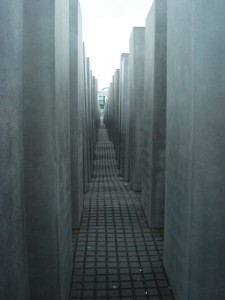 While in Berlin, I visited two large-scale Holocaust memorials – one was the well-publicized and controversial Holocaust Memorial near the Brandenburg Gate; the other was Gleis 17, a seemingly less known spot at Grünewald Station on the S-Bahn.
The official title of the first memorial is Denkmal für die emordeten Juden Europas, or Memorial to the Murdered Jews of Europe, but no one seems to want to use this title. Most just call it Holocaust Memorial and everyone appears to know which one you mean, which is amazing when you consider that every turn of a street corner in Berlin brings a different plaque or statue to be discovered. Whether it be names and dates in brass on the ground, bullet dents building character on a beautiful facade, or the graffiti that’s left up for posterity, every manmade surface in Berlin carries the marks of who-wuz-here and what happened before, one great layer of impasto after another.
The Holocaust Memorial doesn’t have graffiti, though, which has been cause for much controversy – not because people feel that it would be better with graffiti, but because Degussa, the company that made the graffiti-proof coating for the large stone slabs that populate this monument, also made Zyklon B during WWII.
While the inclusion of the word “Murdered” in the Memorial’s full title has the sound of something flashy, the actual monument is stoic and austere. Each of the rectangular stones is of a different height, and the ground that the stones stand on has visible waves of hills and valleys, creating a kind of visual discord that, like the event the
While in Berlin, I visited two large-scale Holocaust memorials – one was the well-publicized and controversial Holocaust Memorial near the Brandenburg Gate; the other was Gleis 17, a seemingly less known spot at Grünewald Station on the S-Bahn.
The official title of the first memorial is Denkmal für die emordeten Juden Europas, or Memorial to the Murdered Jews of Europe, but no one seems to want to use this title. Most just call it Holocaust Memorial and everyone appears to know which one you mean, which is amazing when you consider that every turn of a street corner in Berlin brings a different plaque or statue to be discovered. Whether it be names and dates in brass on the ground, bullet dents building character on a beautiful facade, or the graffiti that’s left up for posterity, every manmade surface in Berlin carries the marks of who-wuz-here and what happened before, one great layer of impasto after another.
The Holocaust Memorial doesn’t have graffiti, though, which has been cause for much controversy – not because people feel that it would be better with graffiti, but because Degussa, the company that made the graffiti-proof coating for the large stone slabs that populate this monument, also made Zyklon B during WWII.
While the inclusion of the word “Murdered” in the Memorial’s full title has the sound of something flashy, the actual monument is stoic and austere. Each of the rectangular stones is of a different height, and the ground that the stones stand on has visible waves of hills and valleys, creating a kind of visual discord that, like the event the 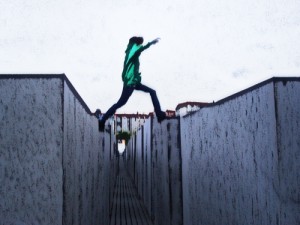 monument recognizes, is difficult to comprehend in any simple kind of understanding. The vertical parallels of stones, and the grey grids created between them, give the feeling of some fleeting yet absolute form and structure, like entering deeper and deeper into the labyrinth of infinity.
The Memorial expects you to be a part of it, to be in it. I watched a group of kids playing games and leaping from stone to stone, a high-stakes version of hopscotch. They were reclaiming the tall grey pillars as their playground in a way that seemed obvious and natural. And why wouldn’t this be a place for play as much as anything else? There are no signs here to state otherwise.
monument recognizes, is difficult to comprehend in any simple kind of understanding. The vertical parallels of stones, and the grey grids created between them, give the feeling of some fleeting yet absolute form and structure, like entering deeper and deeper into the labyrinth of infinity.
The Memorial expects you to be a part of it, to be in it. I watched a group of kids playing games and leaping from stone to stone, a high-stakes version of hopscotch. They were reclaiming the tall grey pillars as their playground in a way that seemed obvious and natural. And why wouldn’t this be a place for play as much as anything else? There are no signs here to state otherwise.
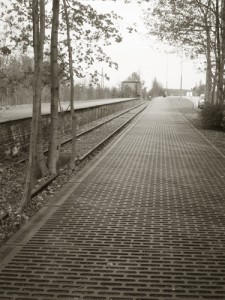
 Gleis 17 was the site of deportations to extermination camps during WWII. The tracks are no longer in use, but remain as part of this memorial, bending off ominously in the distance. Each of the iron grates along the length of the platform is engraved with the date, destination, and number of Jewish passengers on a different deportation.
The tracks here are now quiet and serene. There was hardly anyone else around when I visited, but a fresh single rose left at one of the grates proved that others had been there recently. The only marks of the many that stood there decades before were the numbers pressed into iron every few feet, but there was a feeling about standing there that marked the place unmistakably.
Gleis 17 was the site of deportations to extermination camps during WWII. The tracks are no longer in use, but remain as part of this memorial, bending off ominously in the distance. Each of the iron grates along the length of the platform is engraved with the date, destination, and number of Jewish passengers on a different deportation.
The tracks here are now quiet and serene. There was hardly anyone else around when I visited, but a fresh single rose left at one of the grates proved that others had been there recently. The only marks of the many that stood there decades before were the numbers pressed into iron every few feet, but there was a feeling about standing there that marked the place unmistakably. A little dandelion pushing through the platform grate caught my eye, and at one end of the station trees have grown up through parts of the tracks. Here, nature is reclaiming both the tracks and the memorial. New life is filling up all the spaces between grates and between tracks, but when we left on the S-Bahn, there was a Roma playing accordion while his son held a cup out that no one was filling up. Hardly anyone even looked up.
A little dandelion pushing through the platform grate caught my eye, and at one end of the station trees have grown up through parts of the tracks. Here, nature is reclaiming both the tracks and the memorial. New life is filling up all the spaces between grates and between tracks, but when we left on the S-Bahn, there was a Roma playing accordion while his son held a cup out that no one was filling up. Hardly anyone even looked up.
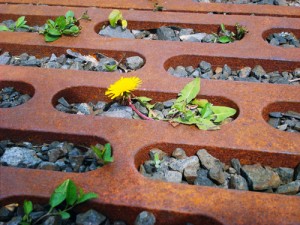
 While in Berlin, I visited two large-scale Holocaust memorials – one was the well-publicized and controversial Holocaust Memorial near the Brandenburg Gate; the other was Gleis 17, a seemingly less known spot at Grünewald Station on the S-Bahn.
The official title of the first memorial is Denkmal für die emordeten Juden Europas, or Memorial to the Murdered Jews of Europe, but no one seems to want to use this title. Most just call it Holocaust Memorial and everyone appears to know which one you mean, which is amazing when you consider that every turn of a street corner in Berlin brings a different plaque or statue to be discovered. Whether it be names and dates in brass on the ground, bullet dents building character on a beautiful facade, or the graffiti that’s left up for posterity, every manmade surface in Berlin carries the marks of who-wuz-here and what happened before, one great layer of impasto after another.
The Holocaust Memorial doesn’t have graffiti, though, which has been cause for much controversy – not because people feel that it would be better with graffiti, but because Degussa, the company that made the graffiti-proof coating for the large stone slabs that populate this monument, also made Zyklon B during WWII.
While the inclusion of the word “Murdered” in the Memorial’s full title has the sound of something flashy, the actual monument is stoic and austere. Each of the rectangular stones is of a different height, and the ground that the stones stand on has visible waves of hills and valleys, creating a kind of visual discord that, like the event the
While in Berlin, I visited two large-scale Holocaust memorials – one was the well-publicized and controversial Holocaust Memorial near the Brandenburg Gate; the other was Gleis 17, a seemingly less known spot at Grünewald Station on the S-Bahn.
The official title of the first memorial is Denkmal für die emordeten Juden Europas, or Memorial to the Murdered Jews of Europe, but no one seems to want to use this title. Most just call it Holocaust Memorial and everyone appears to know which one you mean, which is amazing when you consider that every turn of a street corner in Berlin brings a different plaque or statue to be discovered. Whether it be names and dates in brass on the ground, bullet dents building character on a beautiful facade, or the graffiti that’s left up for posterity, every manmade surface in Berlin carries the marks of who-wuz-here and what happened before, one great layer of impasto after another.
The Holocaust Memorial doesn’t have graffiti, though, which has been cause for much controversy – not because people feel that it would be better with graffiti, but because Degussa, the company that made the graffiti-proof coating for the large stone slabs that populate this monument, also made Zyklon B during WWII.
While the inclusion of the word “Murdered” in the Memorial’s full title has the sound of something flashy, the actual monument is stoic and austere. Each of the rectangular stones is of a different height, and the ground that the stones stand on has visible waves of hills and valleys, creating a kind of visual discord that, like the event the  monument recognizes, is difficult to comprehend in any simple kind of understanding. The vertical parallels of stones, and the grey grids created between them, give the feeling of some fleeting yet absolute form and structure, like entering deeper and deeper into the labyrinth of infinity.
The Memorial expects you to be a part of it, to be in it. I watched a group of kids playing games and leaping from stone to stone, a high-stakes version of hopscotch. They were reclaiming the tall grey pillars as their playground in a way that seemed obvious and natural. And why wouldn’t this be a place for play as much as anything else? There are no signs here to state otherwise.
monument recognizes, is difficult to comprehend in any simple kind of understanding. The vertical parallels of stones, and the grey grids created between them, give the feeling of some fleeting yet absolute form and structure, like entering deeper and deeper into the labyrinth of infinity.
The Memorial expects you to be a part of it, to be in it. I watched a group of kids playing games and leaping from stone to stone, a high-stakes version of hopscotch. They were reclaiming the tall grey pillars as their playground in a way that seemed obvious and natural. And why wouldn’t this be a place for play as much as anything else? There are no signs here to state otherwise.

 Gleis 17 was the site of deportations to extermination camps during WWII. The tracks are no longer in use, but remain as part of this memorial, bending off ominously in the distance. Each of the iron grates along the length of the platform is engraved with the date, destination, and number of Jewish passengers on a different deportation.
The tracks here are now quiet and serene. There was hardly anyone else around when I visited, but a fresh single rose left at one of the grates proved that others had been there recently. The only marks of the many that stood there decades before were the numbers pressed into iron every few feet, but there was a feeling about standing there that marked the place unmistakably.
Gleis 17 was the site of deportations to extermination camps during WWII. The tracks are no longer in use, but remain as part of this memorial, bending off ominously in the distance. Each of the iron grates along the length of the platform is engraved with the date, destination, and number of Jewish passengers on a different deportation.
The tracks here are now quiet and serene. There was hardly anyone else around when I visited, but a fresh single rose left at one of the grates proved that others had been there recently. The only marks of the many that stood there decades before were the numbers pressed into iron every few feet, but there was a feeling about standing there that marked the place unmistakably. A little dandelion pushing through the platform grate caught my eye, and at one end of the station trees have grown up through parts of the tracks. Here, nature is reclaiming both the tracks and the memorial. New life is filling up all the spaces between grates and between tracks, but when we left on the S-Bahn, there was a Roma playing accordion while his son held a cup out that no one was filling up. Hardly anyone even looked up.
A little dandelion pushing through the platform grate caught my eye, and at one end of the station trees have grown up through parts of the tracks. Here, nature is reclaiming both the tracks and the memorial. New life is filling up all the spaces between grates and between tracks, but when we left on the S-Bahn, there was a Roma playing accordion while his son held a cup out that no one was filling up. Hardly anyone even looked up.

 Zeitgeist's Recent Statement: The Big Spill
Zeitgeist's Recent Statement: The Big Spill
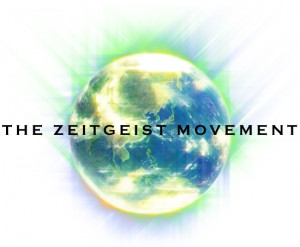 Seeing as we're friendly to the Zeitgeist Movement and the way that they're thinking outside the box, we just wanted to re-post this statement here, which was released by Zeitgeist the other day in reference to the Gulf Coast catastrophe.
While the statement itself doesn't say much about the ideas of the Movement as a whole, you can find out much more at their website:
http://thezeitgeistmovement.com/
(Venus, Florida- May 12rd, 2010)
On the Gulf Coast of the United States the
shock is now setting in for millions of American citizens as we now realize
the true extent of the damage caused by our desire for obsolete and
dangerous fossil fuels, and our perpetuation of an outdated monetary world
society, where the bottom line has always been profit at all costs, be it
human or environmental. It is time for a viable solution to deal with a
system hardwired for self destruction.
It is with that very unfortunate introduction that we, The Zeitgeist
Movement, now must enter the international conversation to express the need
for true change. That word is not some jingoist slogan devised by a focus
group, but the evident desire of the public for a meaningful transition out
of the destructive legacy, the burden of our past mistakes as a maturing
civilization. We only have one Earth; there is no reset button here.
We must break out of our established ideologies that have prevented
progress. Ending the political duality, economic stratification and false
divisions is key to overcoming our apparent historical bondage that says
the future we were promised must remain an elusive dream. We must now
rethink our society and outgrow those parts of it that serve to paralyze
us.
As of Friday, April 30th it was reported by CBS News (US) that the spill
had spread to cover 2,100 square miles and was still spilling at a rate up
to 5,000 barrels (210,000 gallons) a day. As of today, there has been no
progress in stopping this catastrophe. This did not have to happen. It
happened because we continue to use an obsolete technology for the sake of
maintaining a profitable establishment. An establishment that perpetuates
vast inequality in its wages to its employees versus its core owners,
destroys fragile and vital eco-systems, and pollutes our air.
It is time for real change, not empty promises. No amount of socialism or
free market ideology will save us from ourselves, there needs to be a
fundamental re-write of what we think we know, to achieve a sustainable
human enterprise.
Our generation has stood and watched as our planet has been raped and
pillaged, yet we do nothing. Our generation has stood and watched as our
government bailed out the very people who created this economic crisis, yet
we do nothing. Our generation has stood and watched as our rights have been
stripped away from us, and yet we do nothing. Our generation has stood and
watched as we have been handed the problems of the countless generations
before it, and we are preparing to do the same to the next generation, and
we do nothing.
Let us be the first generation to hand solutions to our children and our
children’s children. But we can’t do it alone. Let us break down the
barriers we have created amongst ourselves. We need all of you, every last
one, to say enough is enough in one voice. Not as Americans or Russians,
Christians or Muslims, but as fathers, mothers, brothers and sisters. Let
us destroy the lines between us and work to create a world where our
children are truly safe and free. Let us create a world where we can tell
our children that they can be and do whatever their heart desires, and know
deep inside us we are telling them the truth. Let our generation be the
one.
We have the tools, we have the knowledge, we have the technology. It is
time we make the transition to a world, an economy, and a future we all
deserve regardless of geographic location or economic disposition. As long
as we rely on legacy systems defined in a 19th century mentality all we
will do is spin our wheels while a parade of economic and ecologic
disasters visits us again and again. It is time to pull the plug on this
charade because as you will find out, there is a better way.
We, the Zeitgeist Movement representatives, reach out to you so that we can
all work together to do what must be done. Every man, woman and child has a
voice, but together we can create one voice so deafening that no one will
have a choice but to listen. But it requires you. It requires you put away
preconceived notions you have been told about “the way things are” as
if it is the only way, because it's not! Our way of thinking will no longer
sustain us. We can either remain in the house of cards we have built and
watch it collapse all around us, or we can, through the best our society
has to offer, begin to construct a stable mature and thriving society so
that the Gulf Coast Oil Spill, the Exxon Valdez and many others are nothing
more then an embarrassing footnote in history.
The choice is yours.
www.thezeitgeistmovement.com
Seeing as we're friendly to the Zeitgeist Movement and the way that they're thinking outside the box, we just wanted to re-post this statement here, which was released by Zeitgeist the other day in reference to the Gulf Coast catastrophe.
While the statement itself doesn't say much about the ideas of the Movement as a whole, you can find out much more at their website:
http://thezeitgeistmovement.com/
(Venus, Florida- May 12rd, 2010)
On the Gulf Coast of the United States the
shock is now setting in for millions of American citizens as we now realize
the true extent of the damage caused by our desire for obsolete and
dangerous fossil fuels, and our perpetuation of an outdated monetary world
society, where the bottom line has always been profit at all costs, be it
human or environmental. It is time for a viable solution to deal with a
system hardwired for self destruction.
It is with that very unfortunate introduction that we, The Zeitgeist
Movement, now must enter the international conversation to express the need
for true change. That word is not some jingoist slogan devised by a focus
group, but the evident desire of the public for a meaningful transition out
of the destructive legacy, the burden of our past mistakes as a maturing
civilization. We only have one Earth; there is no reset button here.
We must break out of our established ideologies that have prevented
progress. Ending the political duality, economic stratification and false
divisions is key to overcoming our apparent historical bondage that says
the future we were promised must remain an elusive dream. We must now
rethink our society and outgrow those parts of it that serve to paralyze
us.
As of Friday, April 30th it was reported by CBS News (US) that the spill
had spread to cover 2,100 square miles and was still spilling at a rate up
to 5,000 barrels (210,000 gallons) a day. As of today, there has been no
progress in stopping this catastrophe. This did not have to happen. It
happened because we continue to use an obsolete technology for the sake of
maintaining a profitable establishment. An establishment that perpetuates
vast inequality in its wages to its employees versus its core owners,
destroys fragile and vital eco-systems, and pollutes our air.
It is time for real change, not empty promises. No amount of socialism or
free market ideology will save us from ourselves, there needs to be a
fundamental re-write of what we think we know, to achieve a sustainable
human enterprise.
Our generation has stood and watched as our planet has been raped and
pillaged, yet we do nothing. Our generation has stood and watched as our
government bailed out the very people who created this economic crisis, yet
we do nothing. Our generation has stood and watched as our rights have been
stripped away from us, and yet we do nothing. Our generation has stood and
watched as we have been handed the problems of the countless generations
before it, and we are preparing to do the same to the next generation, and
we do nothing.
Let us be the first generation to hand solutions to our children and our
children’s children. But we can’t do it alone. Let us break down the
barriers we have created amongst ourselves. We need all of you, every last
one, to say enough is enough in one voice. Not as Americans or Russians,
Christians or Muslims, but as fathers, mothers, brothers and sisters. Let
us destroy the lines between us and work to create a world where our
children are truly safe and free. Let us create a world where we can tell
our children that they can be and do whatever their heart desires, and know
deep inside us we are telling them the truth. Let our generation be the
one.
We have the tools, we have the knowledge, we have the technology. It is
time we make the transition to a world, an economy, and a future we all
deserve regardless of geographic location or economic disposition. As long
as we rely on legacy systems defined in a 19th century mentality all we
will do is spin our wheels while a parade of economic and ecologic
disasters visits us again and again. It is time to pull the plug on this
charade because as you will find out, there is a better way.
We, the Zeitgeist Movement representatives, reach out to you so that we can
all work together to do what must be done. Every man, woman and child has a
voice, but together we can create one voice so deafening that no one will
have a choice but to listen. But it requires you. It requires you put away
preconceived notions you have been told about “the way things are” as
if it is the only way, because it's not! Our way of thinking will no longer
sustain us. We can either remain in the house of cards we have built and
watch it collapse all around us, or we can, through the best our society
has to offer, begin to construct a stable mature and thriving society so
that the Gulf Coast Oil Spill, the Exxon Valdez and many others are nothing
more then an embarrassing footnote in history.
The choice is yours.
www.thezeitgeistmovement.com


